EXPEDITIONS:
Vocal behaviour between mother and offspring in impala.
Expedition to habitats of impala antelope. Namibia, January-February 2016.
Participants: Volodin I.A., Volodina E.V., Frey R.
Supported by the Russian Science Foundation (RSF, grant 14-14-00237).
Now is January. Seven months passed since the end of the rutting period in impala antelope in the African bush of Namibia. The rut was very active, so should be many offspring. Namibia is located in the southern hemisphere, so January is the middle of hot summer, which should change to the wet season with abundant rains. But African climate is severe, drought may last longer than usual. In addition, both mothers and offspring are under threat of predators, cheetahs and leopards. How vocal behaviour help in their survival? What calls impala females use for supporting communication with their offspring in herd, in dense bush, day and night? What calls use the young when lost and looking for a mother? How often impala female and offspring vocalize? And what about vocal communication of males: are they silent after the rut period, or use some calls, for example, in frames of vigilance behaviour? To find the answers to these questions, we again go to Namibia, to the Okambara safari ranch, now to study the behavior of the impala antelope in natural habitats during the young raising season.
1. Impala female and young.
The Okambara safari ranch has a territory about 15000 hectares and specializes in breeding wild animals in almost natural environment. In January, females and young impala stay in the same places where the rut was held in May. So we found them immediately, on the first day after arrival. But there were only few cubs, much fewer than females. What is the matter? One explanation is the effect of severe drought, so it wasn’t so easy for the numerous offspring to survive.
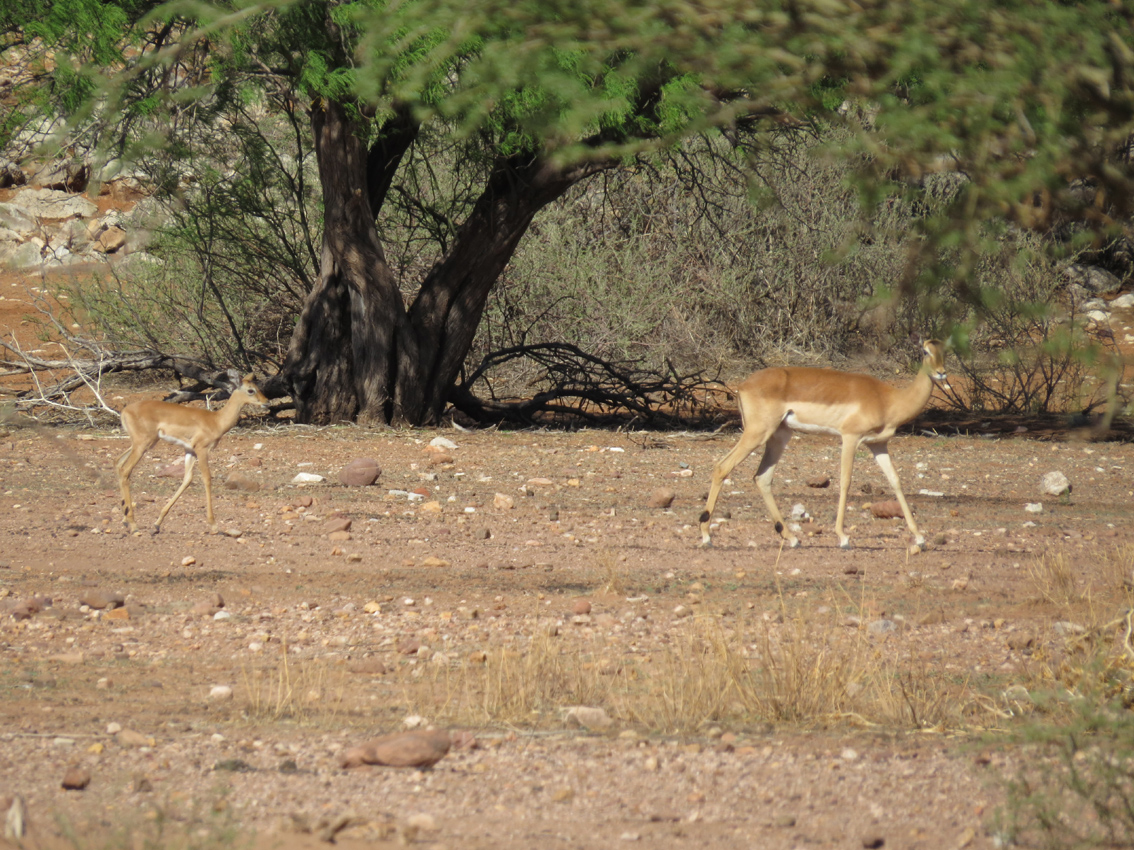
2. No rains - no grass.
It had not rained for a very long time; rains should have started a month ago. There is no grass, and bushes and low trees are mostly without leaves. If there is no rain, the leaves will not appear. Some trees have already begun to shed young leaves. The farm owners began to fear that the animals would starve, and began to provide them rolls of hay near ponds.
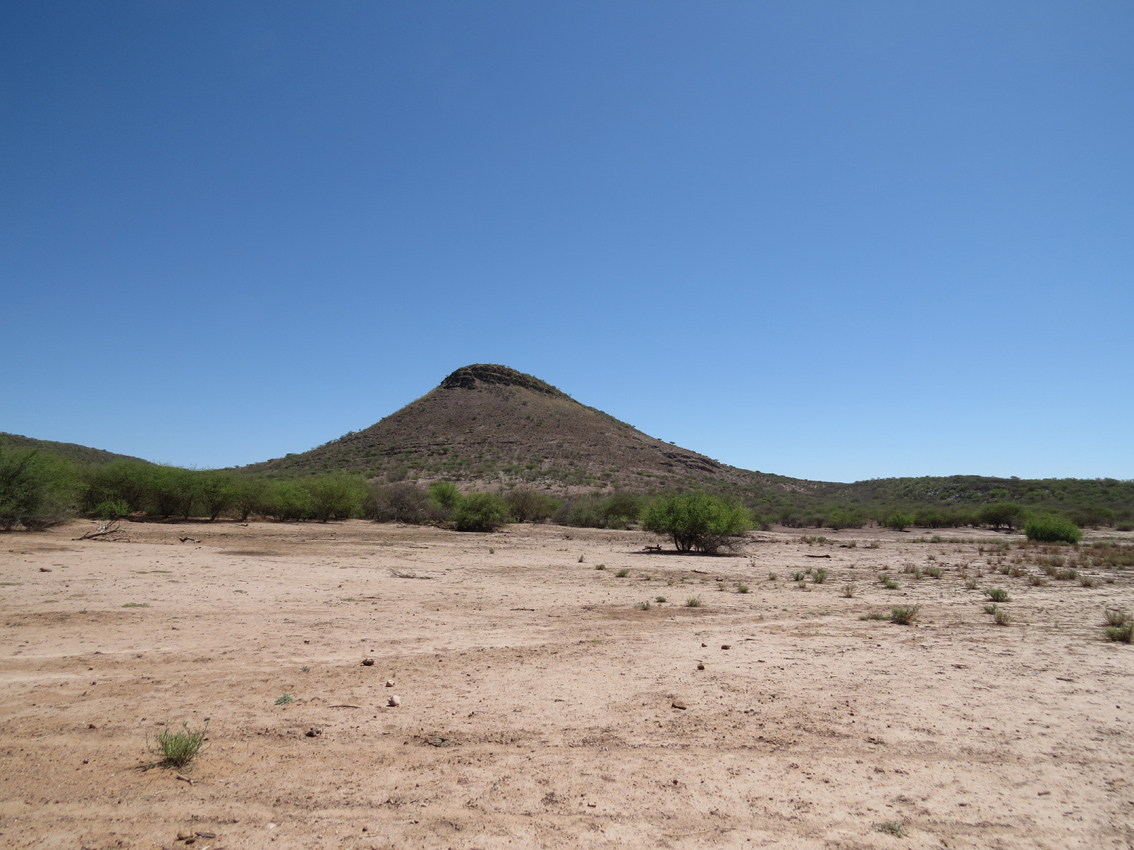
3. Females pass one by one through the bush.
Morning observations from the hides showed that females impala move every day from the plain to the mountains and back. However, their route is constantly changing. This can be understood, because if you walk in the same places, the eaten grass and leaves just do not have time to grow.
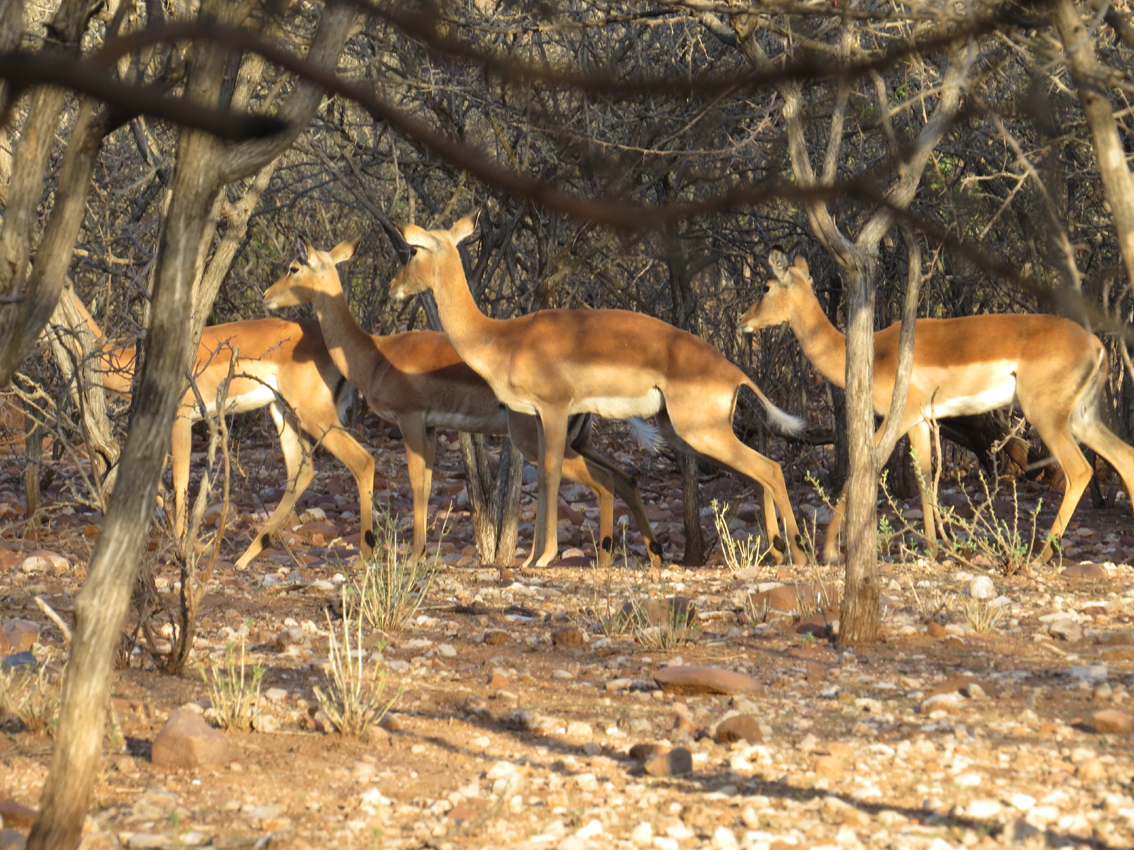
4. Male impala.
Male impala stay in the same places as females with young, sometimes in the same groups with them. But more often they walk alone or in small groups of several males. When males spot the researcher, they move for some distance away, then stop and produce loud whistling breaths as alarm calls toward a human. The same whistling breaths they used in sequences of rutting calls in May rut period.
Sound Loud alarm snorts of a male impala.
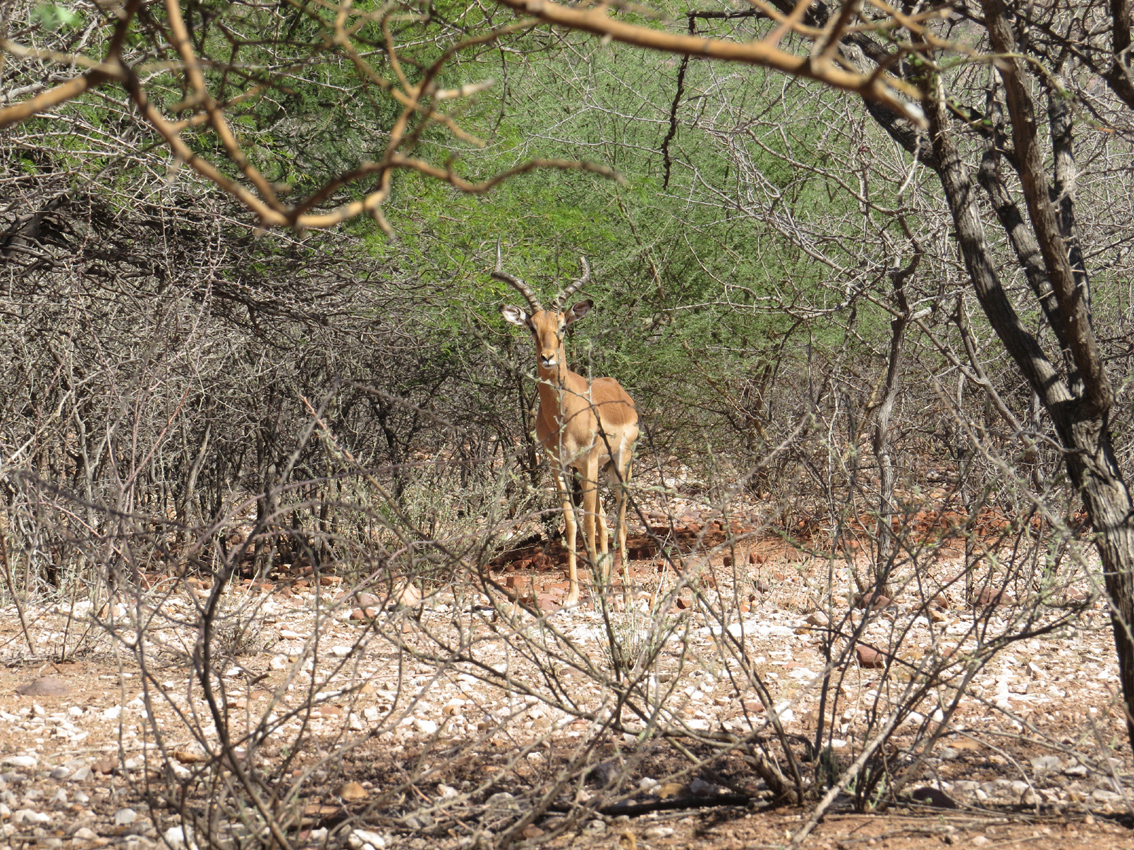
5. Automated devices for recording impala calls.
After preliminary visual observations, we know in what places groups and herds of impala with young are grazing. In places where impala groups pass regularly, we mount the devices for automatic recording of sounds (songmeters). These devices are scheduled to work day and night, recording the sounds of all passing animals. We put the songmeters inside the crowns of thorny bushes to protect them from the curiosity of baboons, which, as shown by sad experience, can severely damage microphones. In order to make sure that the recorded sounds really belong to the impala females and young, we will use the referential recordings that were obtained when we could directly see the calling impala and make video how they vocalize, with their mouth closed or open. These recordings are necessary as referential materials for analysis of automatic recordings made in the absence of researchers.
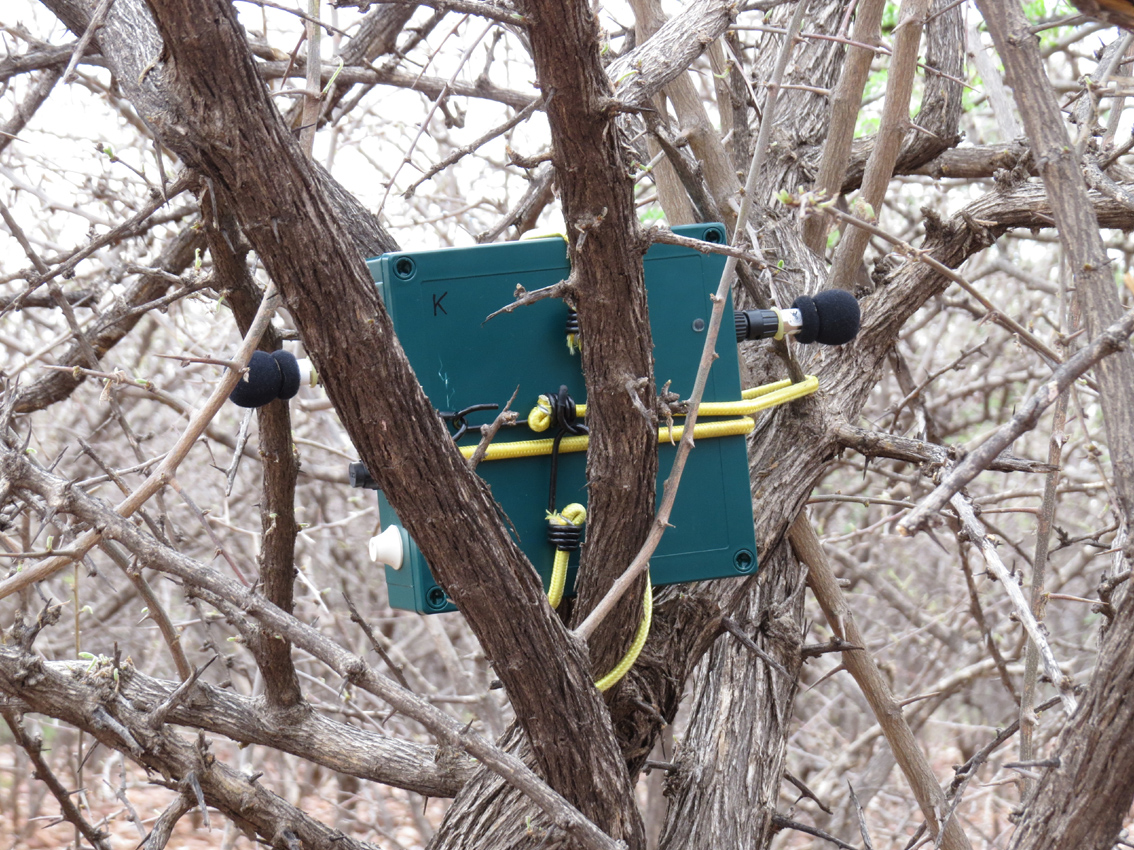
6. Tropical rain.
It's finally raining! And not just rain - tropical rain for many hours. Water stands as a wall, no cloak will help. Streams of water are accompanied by sparkling lightning and peals of thunder.
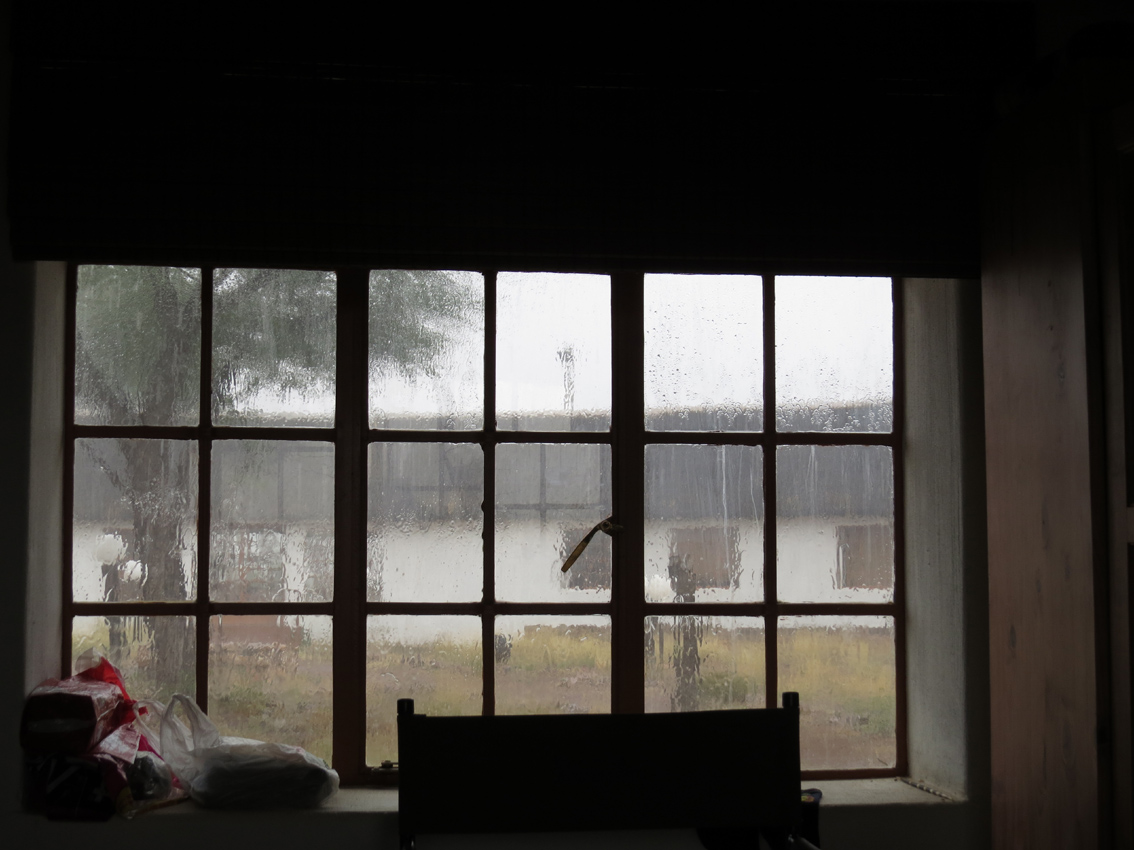
7. Puddles in the desert.
Next morning, all the surroundings are covered in puddles. The rain was so strong that despite the sandy soil, the water stands in any depression. Immediately after the rain, a new strange sound appeared - a floating polyphonic chorus of many melodious voices. It turned out to be frogs. Thousands and tens of thousands, of many species. They waited for this rain, burrowing in moist soil deep underground. And from the first hours of the wet season began to breed. Their appearance is so sudden that according to African legends, they fall to the ground with raindrops.
Amphibian chorus after rain Sound
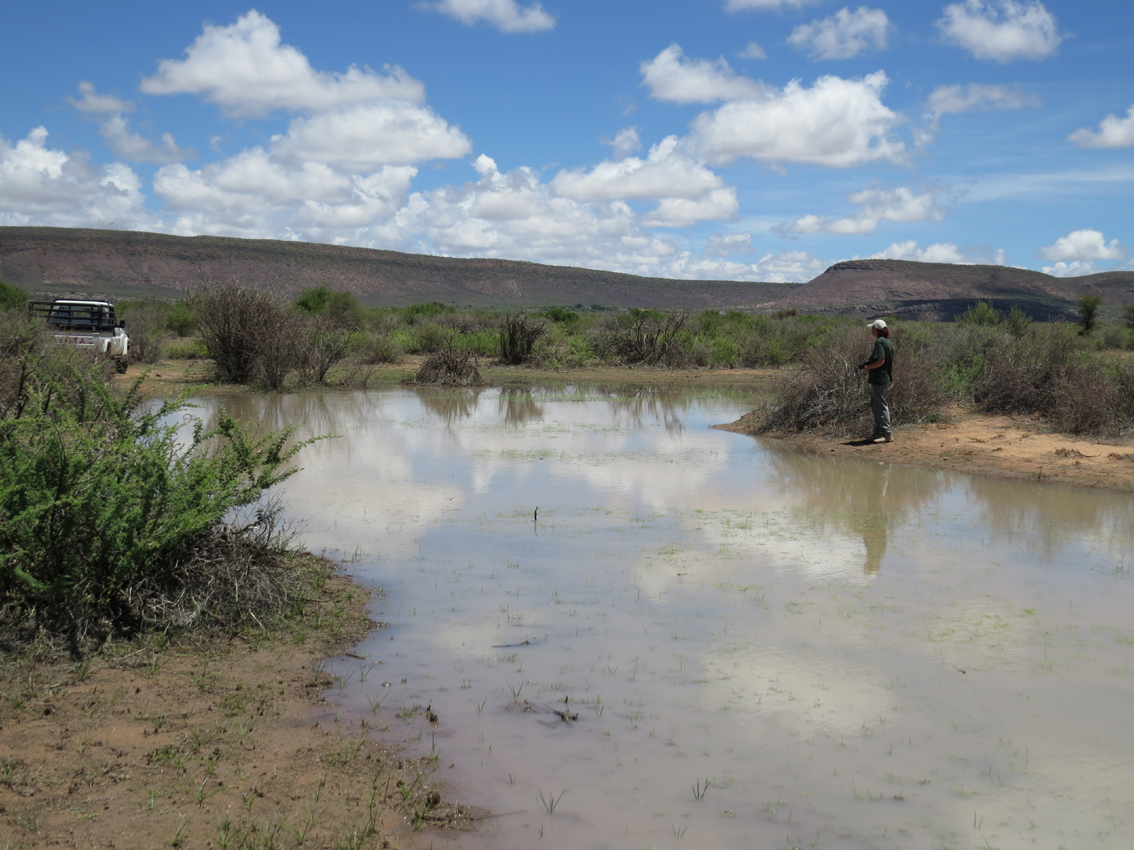
8. Ñàìåö àôðèêàíñêîé ëÿãóøêè-áûêà â áðà÷íîì íàðÿäå.
8. Male African bullfrog in mating outfit
These frogs are not real bull frogs. Their correct biological name is burrowing African spotted frogs Pyxicephalus adspersus. But they are larger than real bullfrogs living in America, and moo very similar to real bulls or cows.
Video. The male puts all his energy into mooing - he moo as if “with his whole body”. Such calls attract females and deter rival males. This is better than fighting, because in fights the males inflict quite sensitive wounds on each other. (video).
Low-frequency male courtship calls during the breeding season (sound).
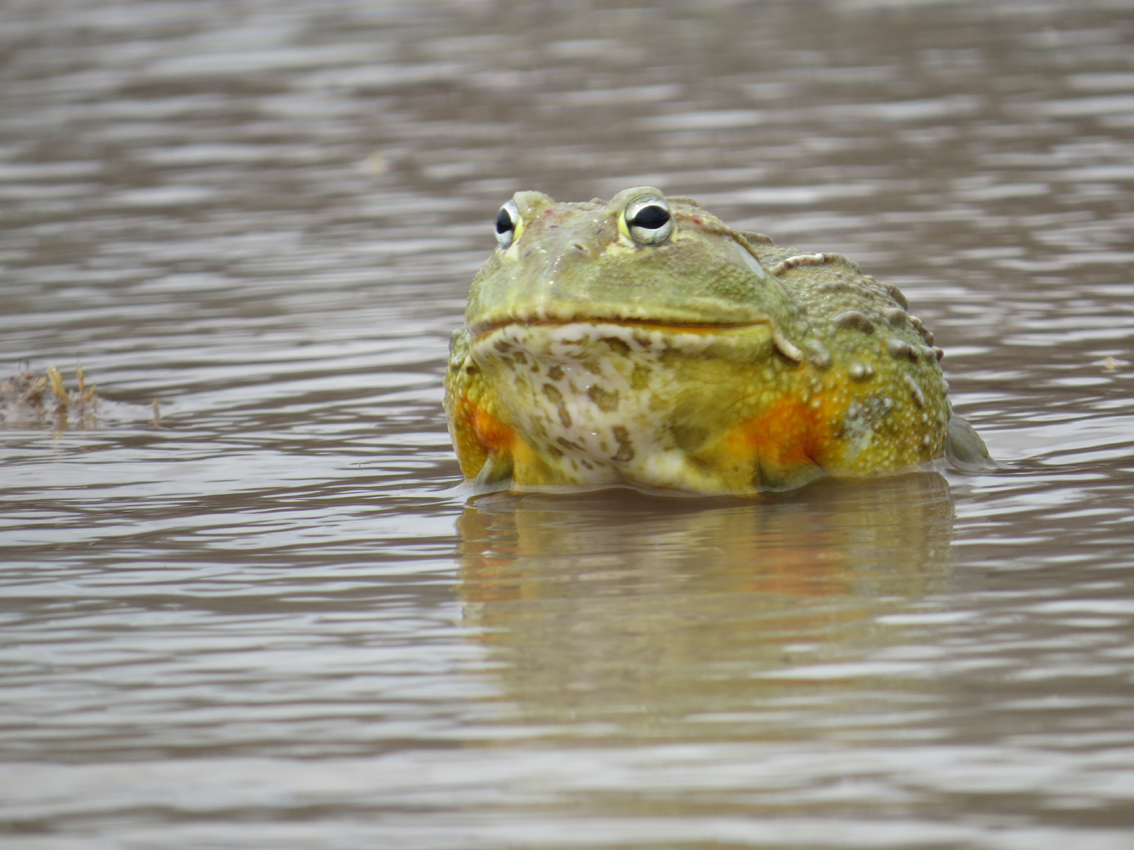
9. Mating frogs.
If you pull for a long time with reproduction, then you cannot catch it in a short period of rains. Amphibian mating occurs the very next morning after the first rainfall.
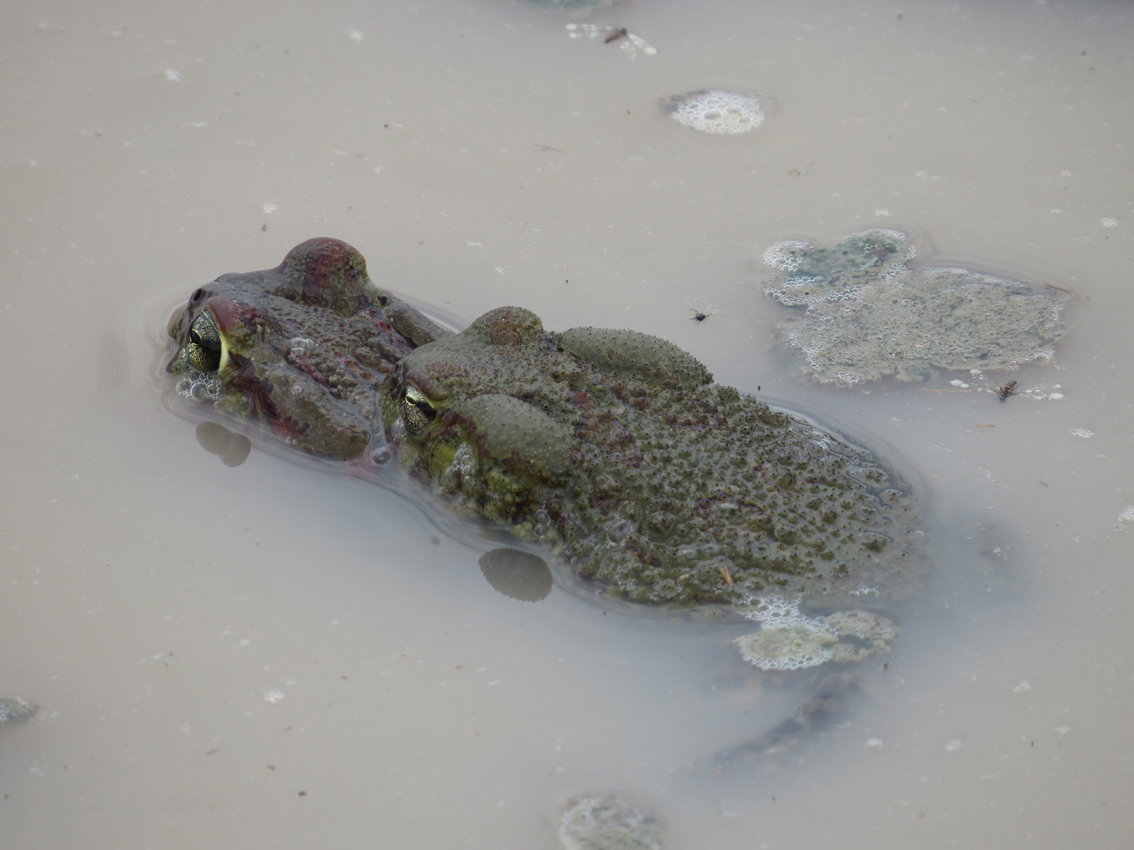
10. Diplopod.
Large invertebrates diplopods appear in many. Some of them are longer than 20 cm. Diplopods got their name because of the many tiny legs located on the sides in pairs.
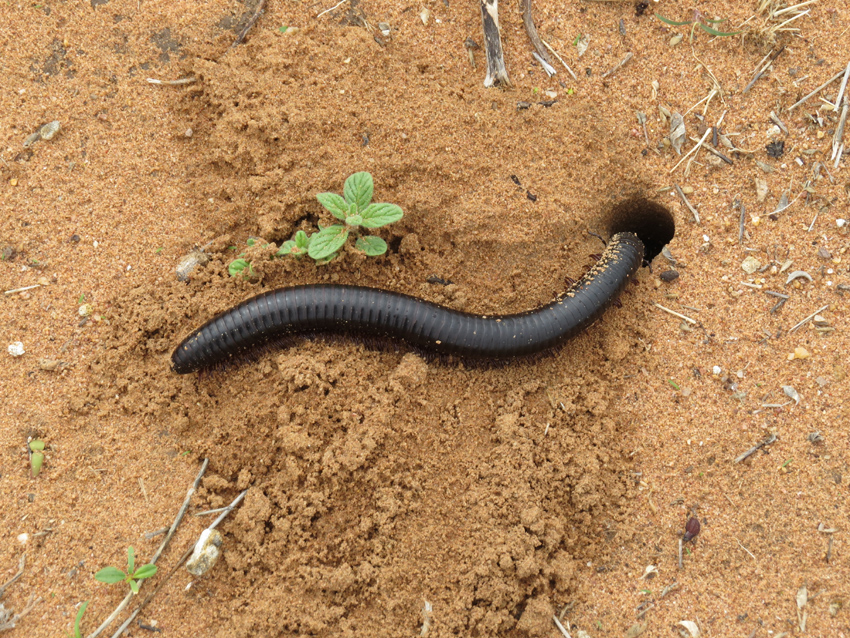
11. Breeding is not an obstacle to feeding.
During the drought, the frogs sat underground in deep numbness and did not feed. Now they have to catch up. This male burrowing African spotted frog throws out his tongue at lightning speed to capture and eat a diplopod about 8-10 cm long. Rate the size of the frog!
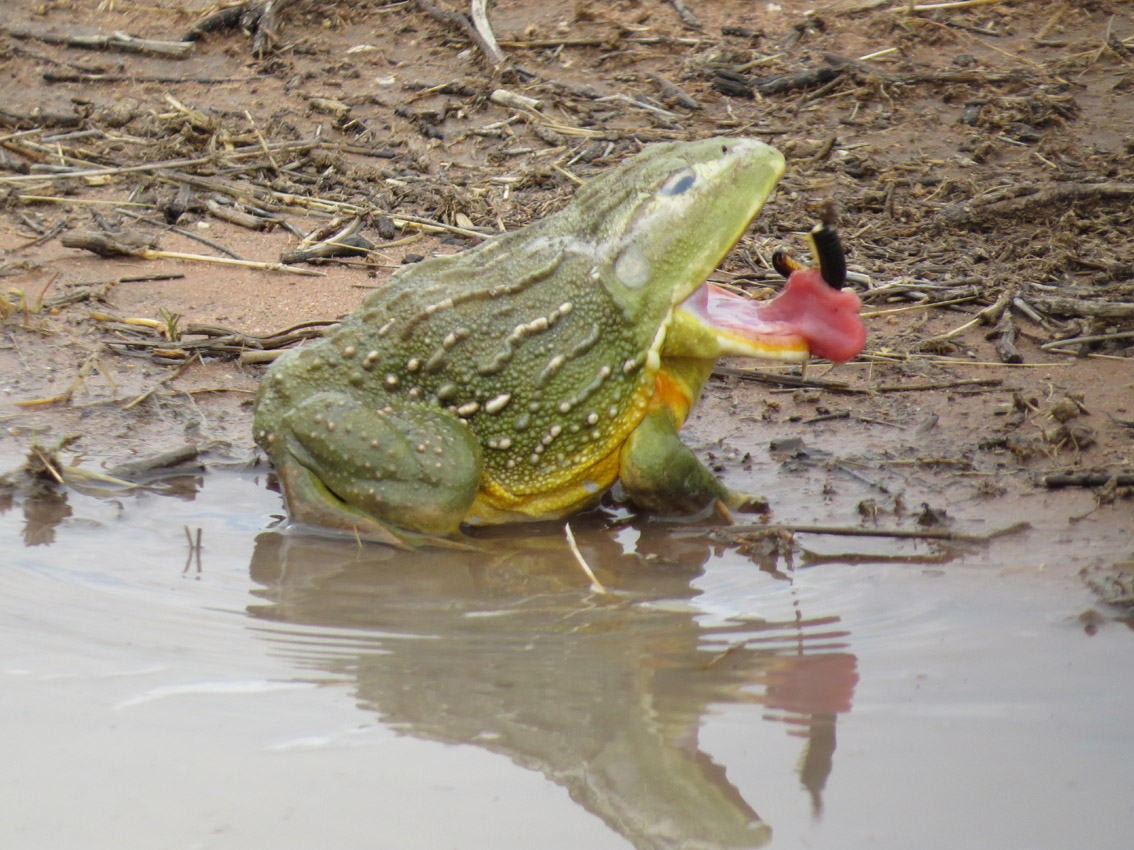
12. Tadpoles.
The breeding rate is amazing. Two days after rain and already tadpoles. This speed of development is dictated by the danger of death due to drying out of the puddle. A slight delay between two consecutive rains - and everything will end badly for those tadpoles who did not manage to turn into a frog in a short time and ride off in search of a deeper puddle.
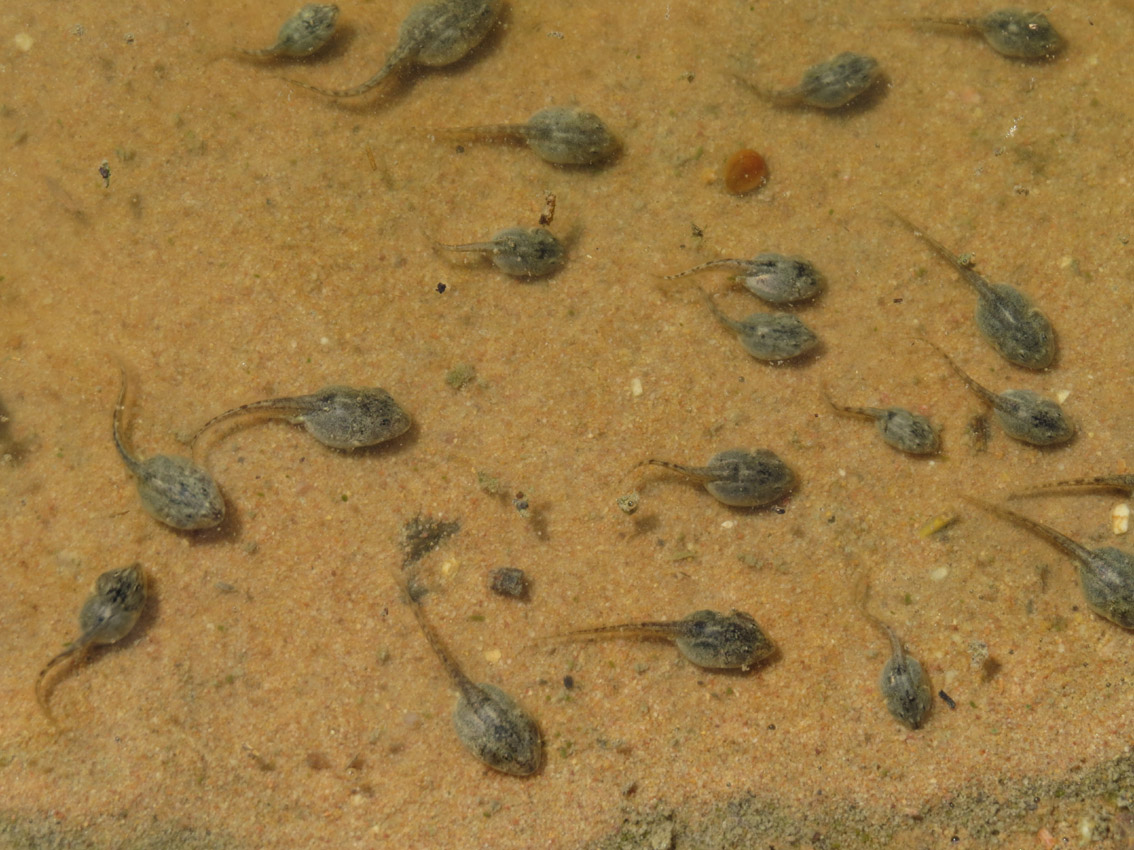
13. Cicada.
Frogs are not the only ones who start singing after rains. Large cicadas appear on the bushes. They are much easier to hear than to see. Cicadas advertize themselves with their endless songs, competing with each other in volume and mastery.
Sound Cicada chirping Cicada_Namibia1.wav
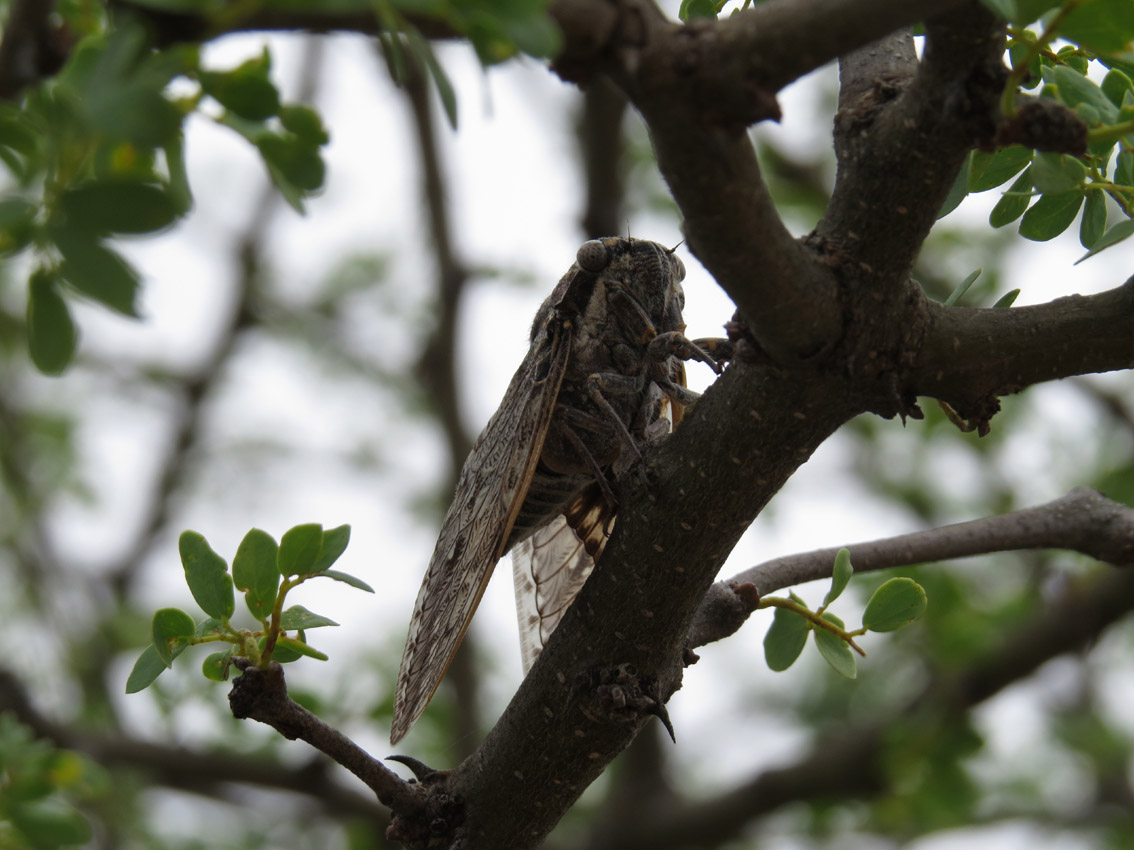
14. Flowering acacia bushes.
Grass literally appears before our eyes, and the spiny bushes of the bush are covered with yellow flowers.
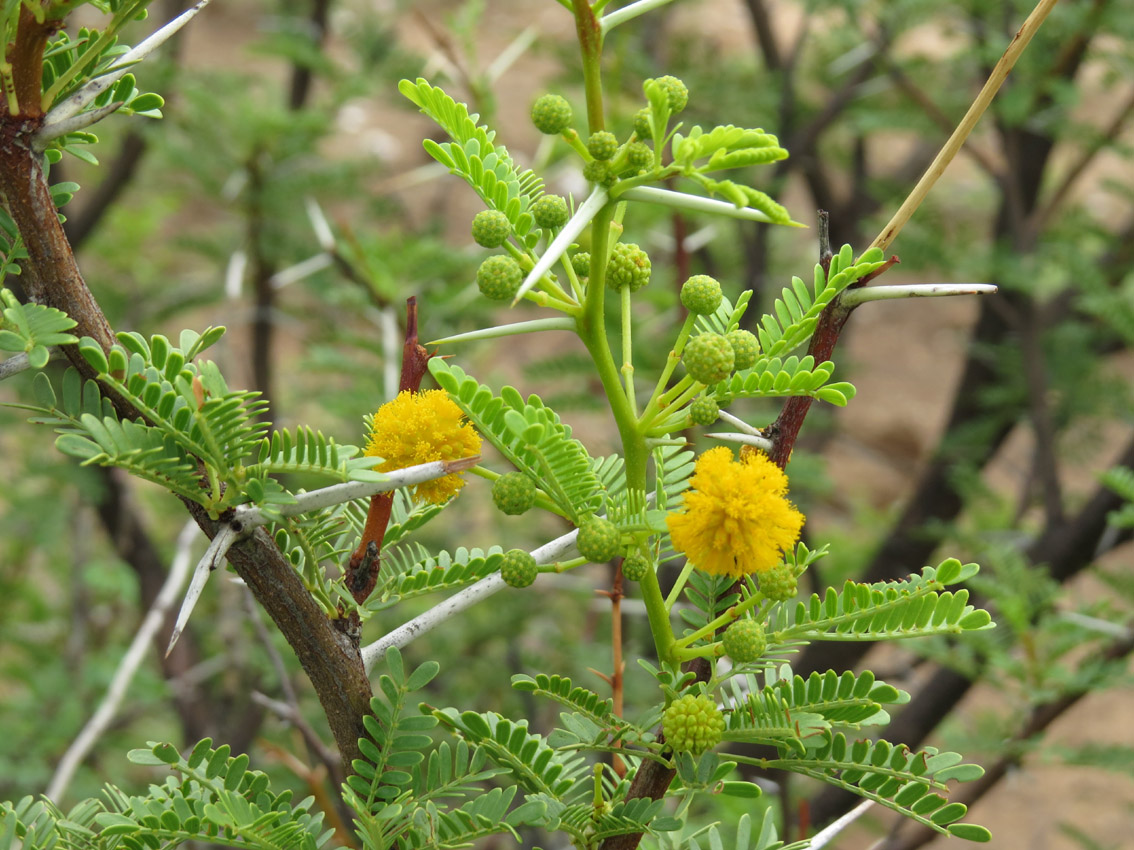
15. Carabid beetle feeds on pollen.
Their pollen serves as food for carabid beetles, which in many fly to feed on them.
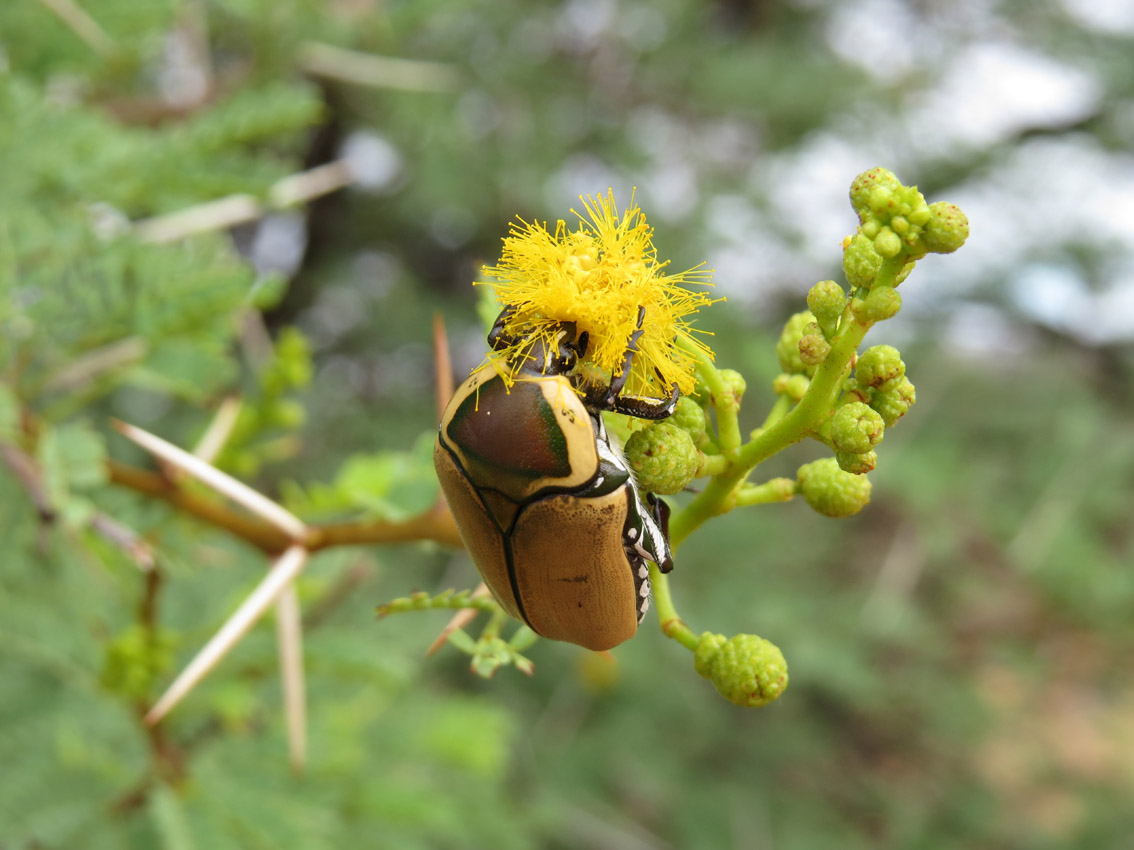
16. Bindweed.
Flowers very similar to our bindweed, appear among the first. Later they climb the bush bushes, like little vines.
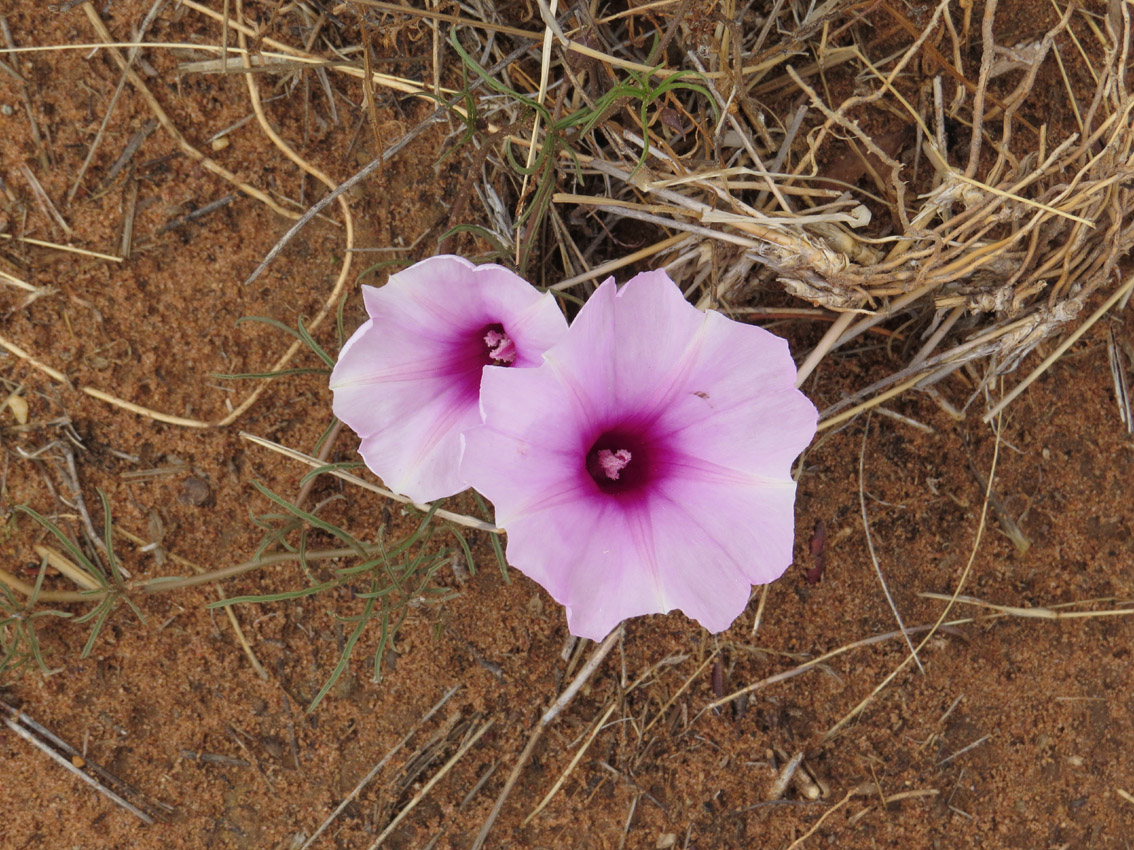
17. Flowers.
Every day there are new flowers.
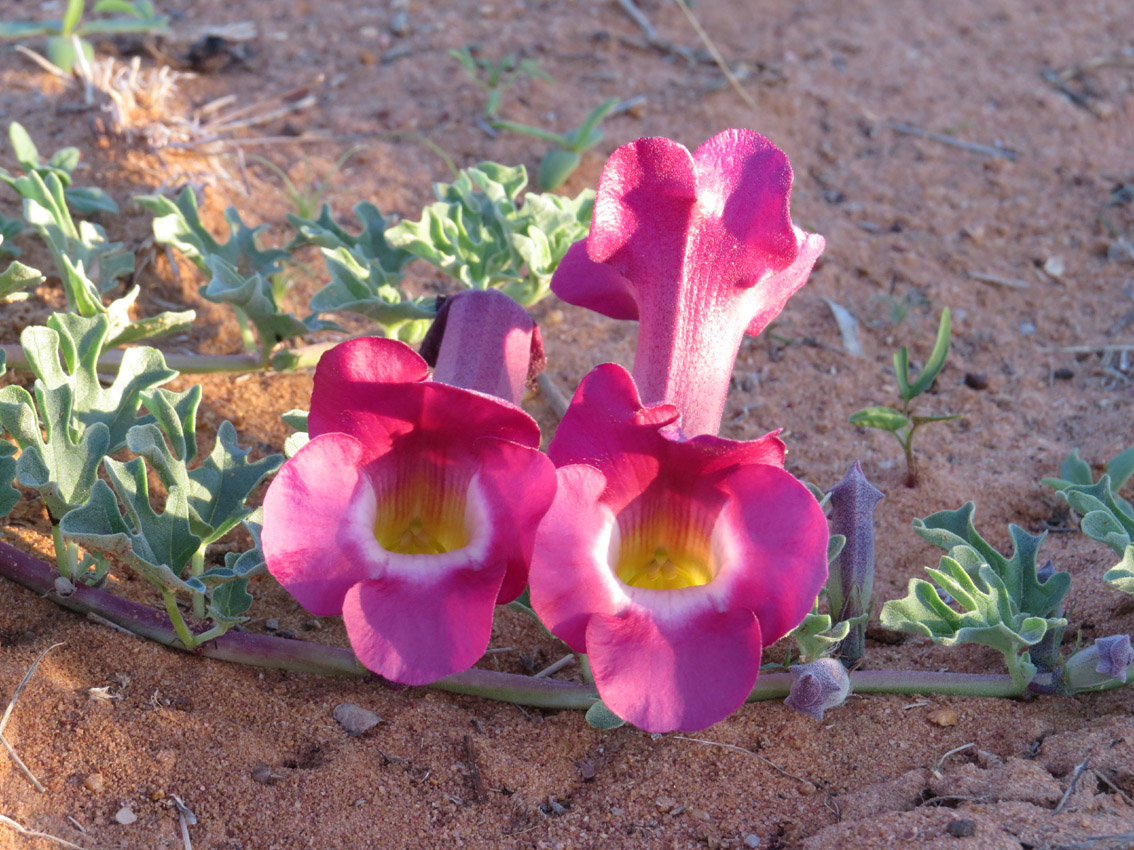
18. Desert amaryllis.
Before the rains there was nothing on this place. Then a rosette of leaves appeared, and after a few days - luxurious flowers.
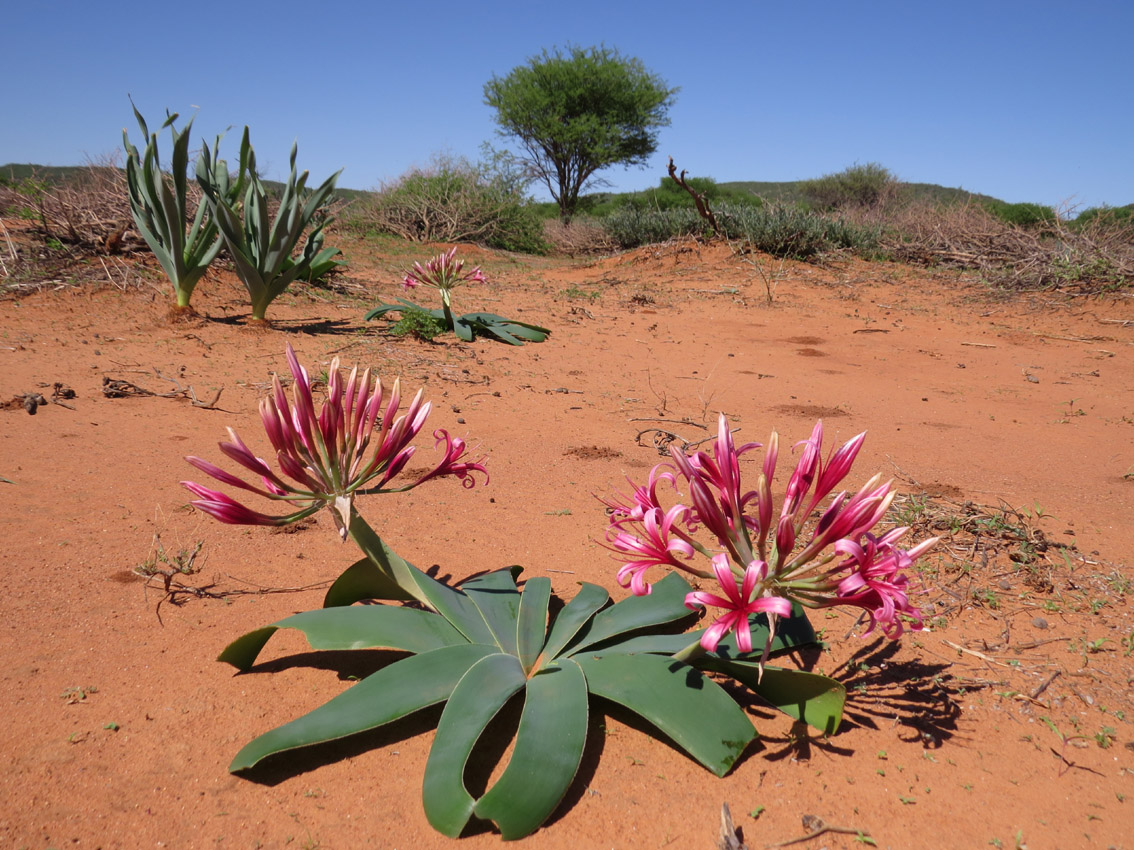
19. African helmeted turtle Pelomedusa subrufa
In addition to amphibians, puddles are actively occupying medium-sized African helmeted turtles. The peculiarity of these turtles is that in case of danger they do not retract their heads, like the Central Asian turtles familiar to us, but lay it under the carapace of one side. And where did they hide during the drought?
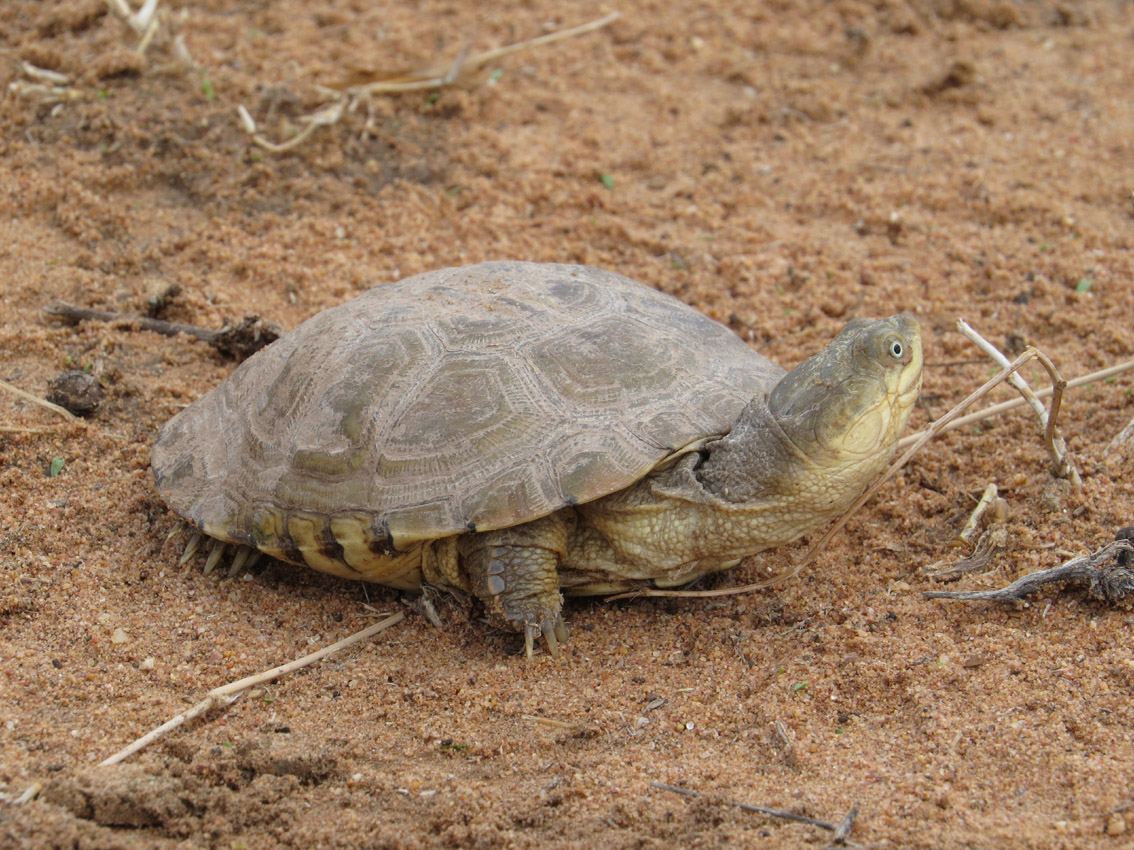
20. Our car is stuck tightly in mud.
An attempt to go around such a turtle floating in a water-laden track of the road turned out to be that our car was stuck tightly in wet sand. In the rut of the road, the sand is tamped, but it is worth a little move to the side, as the wheels immediately fall in mud. So tight that only a cable, a pair of shovels and sheets of iron under the wheels were effective. Louis, Dirk and Suzanne, thank you for helping us get our car out!
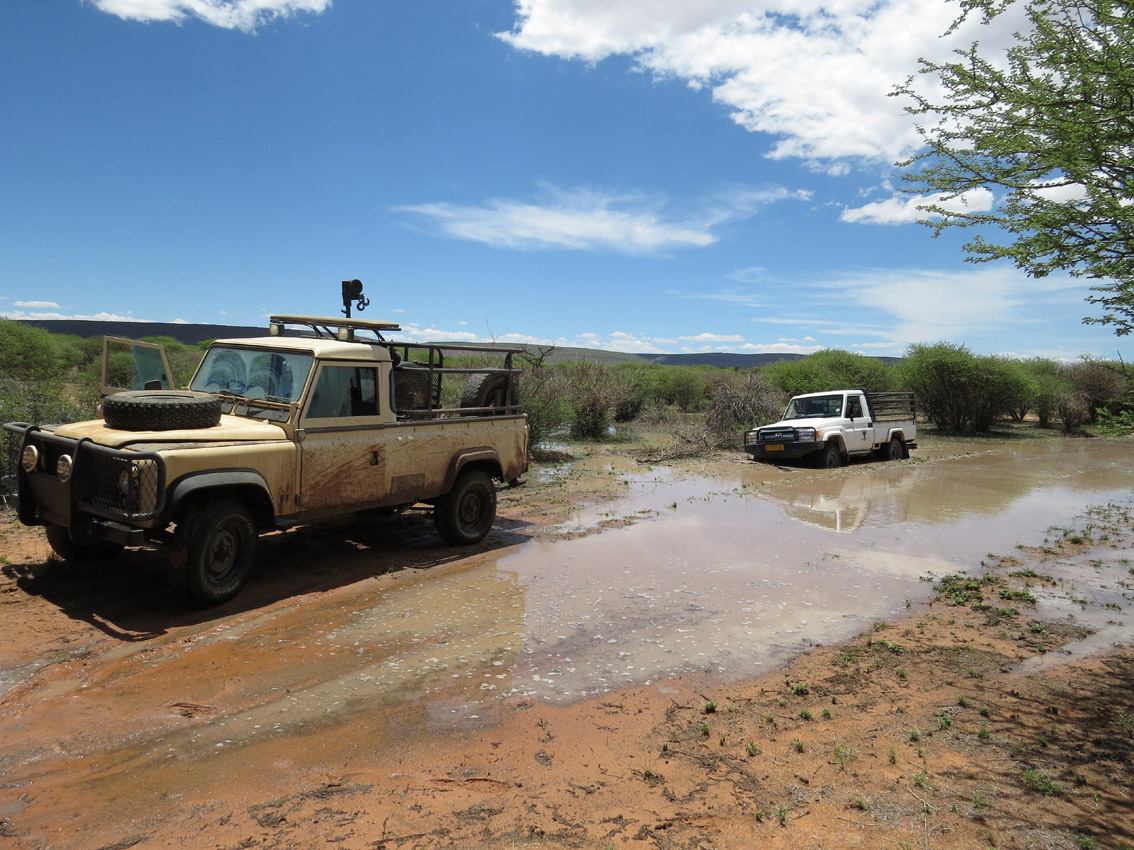
21. Antique car.
Transport used in these places many years ago.
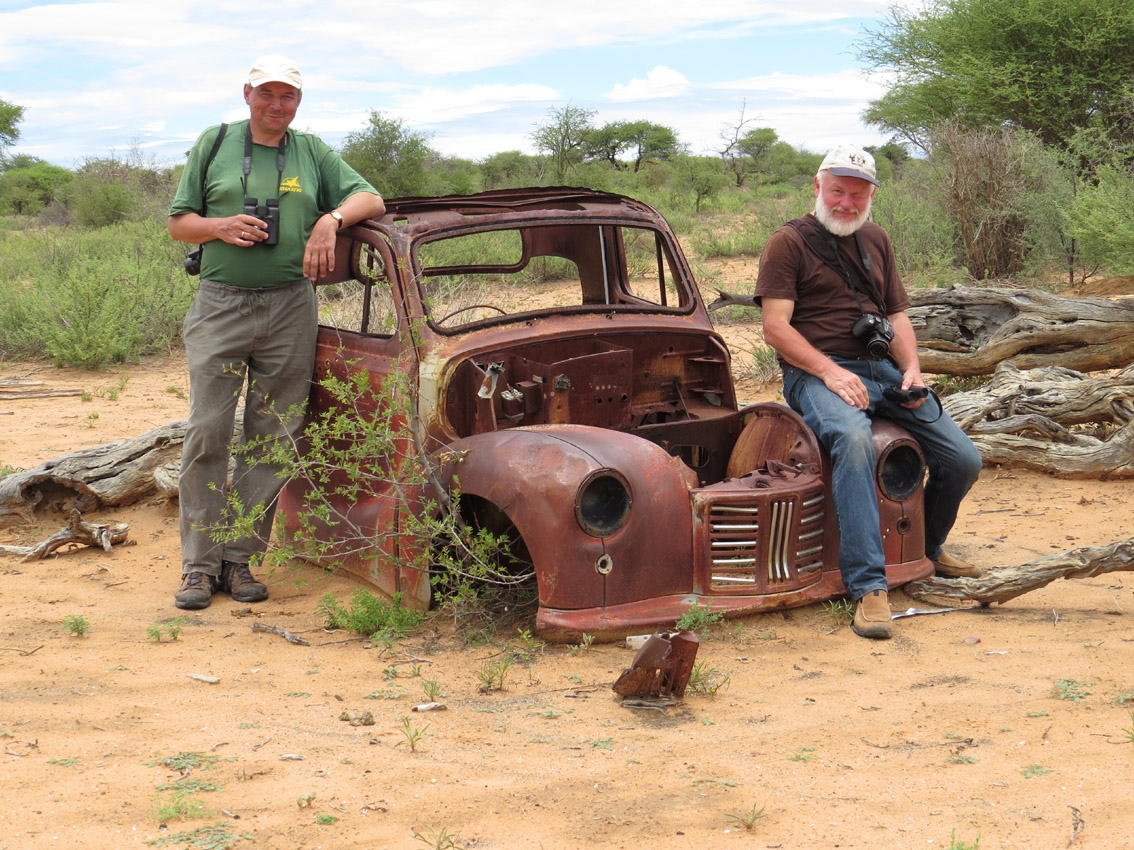
22. Cape ground squirrel Xerus inaurus.
Since it is very hot during the day, most rodents are active at dusk and at night. And only Cape ground squirrel is not afraid of the heat of the day. A Cape ground squirrel can use its long fluffy tail as an umbrella from the sun.
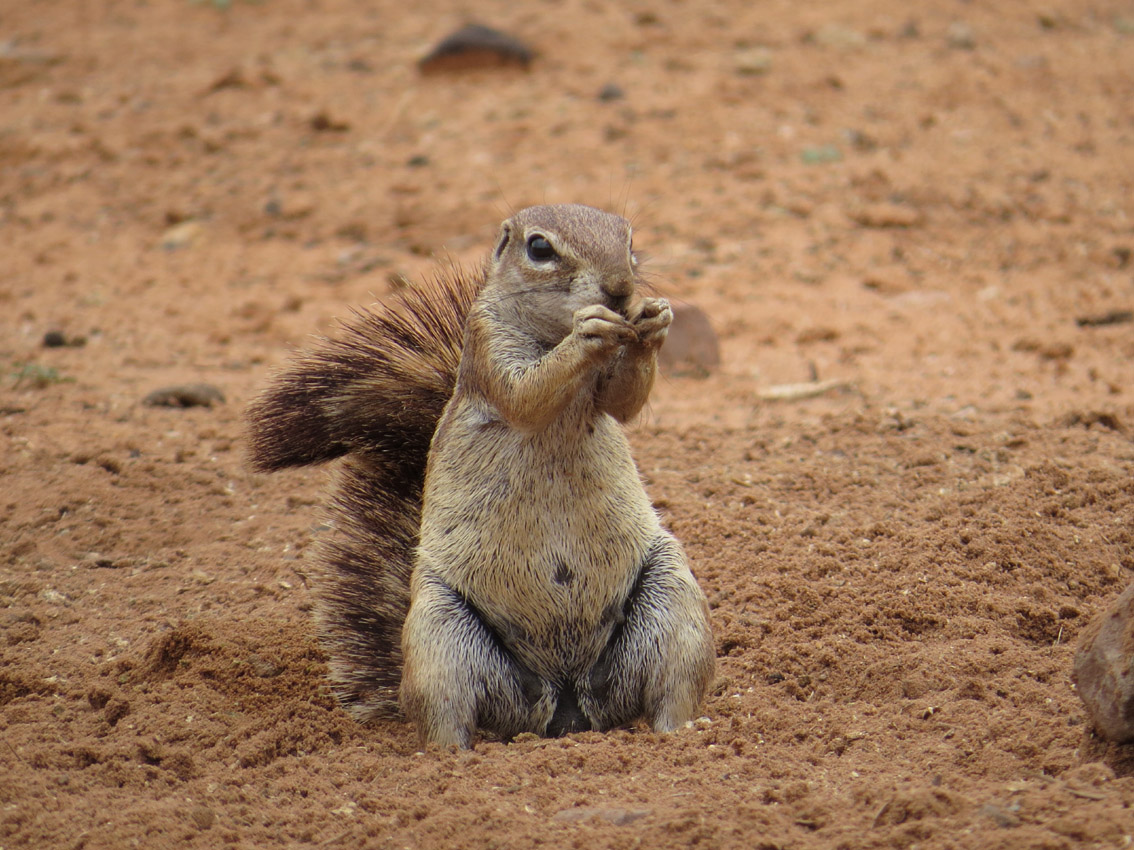
23. Elephant shrew.
Seeing an elephant shrew is a big luck. They’re not hiding, they’re just small, a little bigger than a mouse, and they live in burrows under the bushes. They have long hind legs, like a jerboa and a proboscis like an elephant calf, with which it tasted plants growing under bushes.
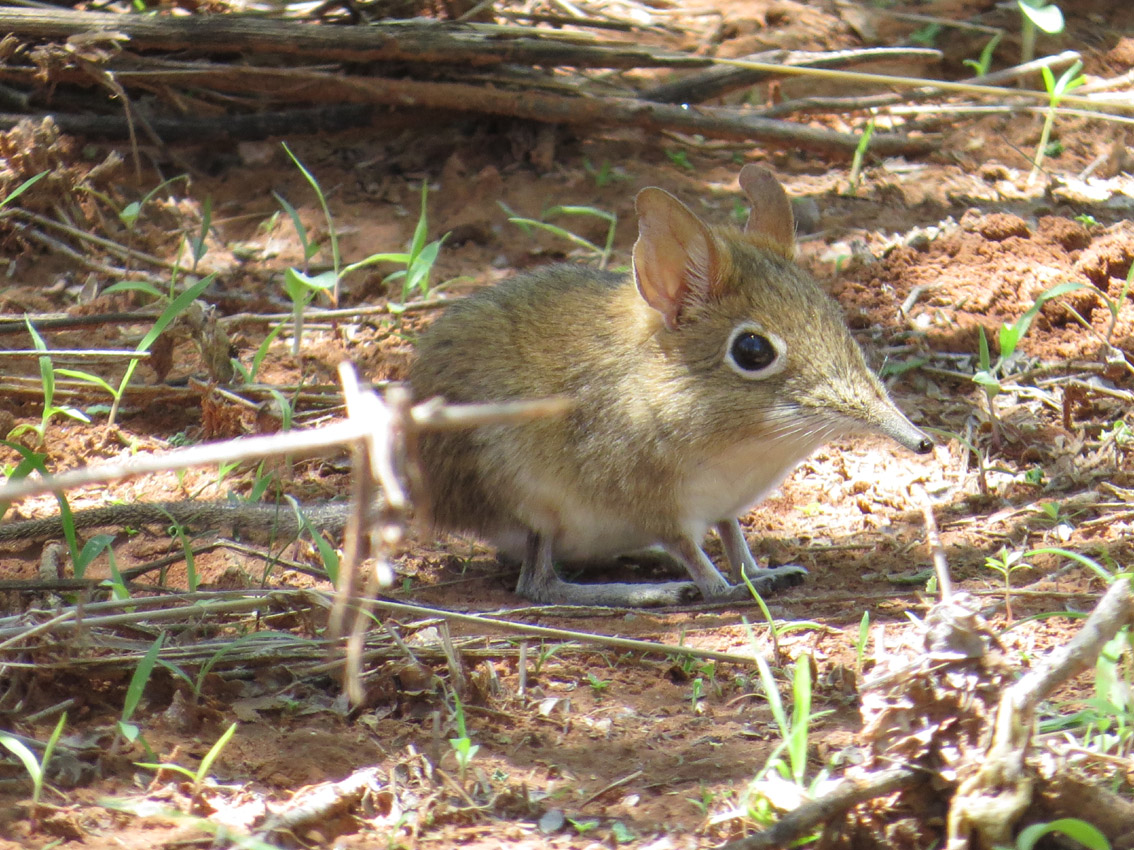
24. Rock hyrax.
Rock hyraxes are fearful, but curious. Every morning they loudly call-over. And in between the calls, they look at the researcher, waiting for impalas opposite their home residential rock
Morning call-over of rock hyraxes Procavia_capensis2_call-over.wav
(sound)
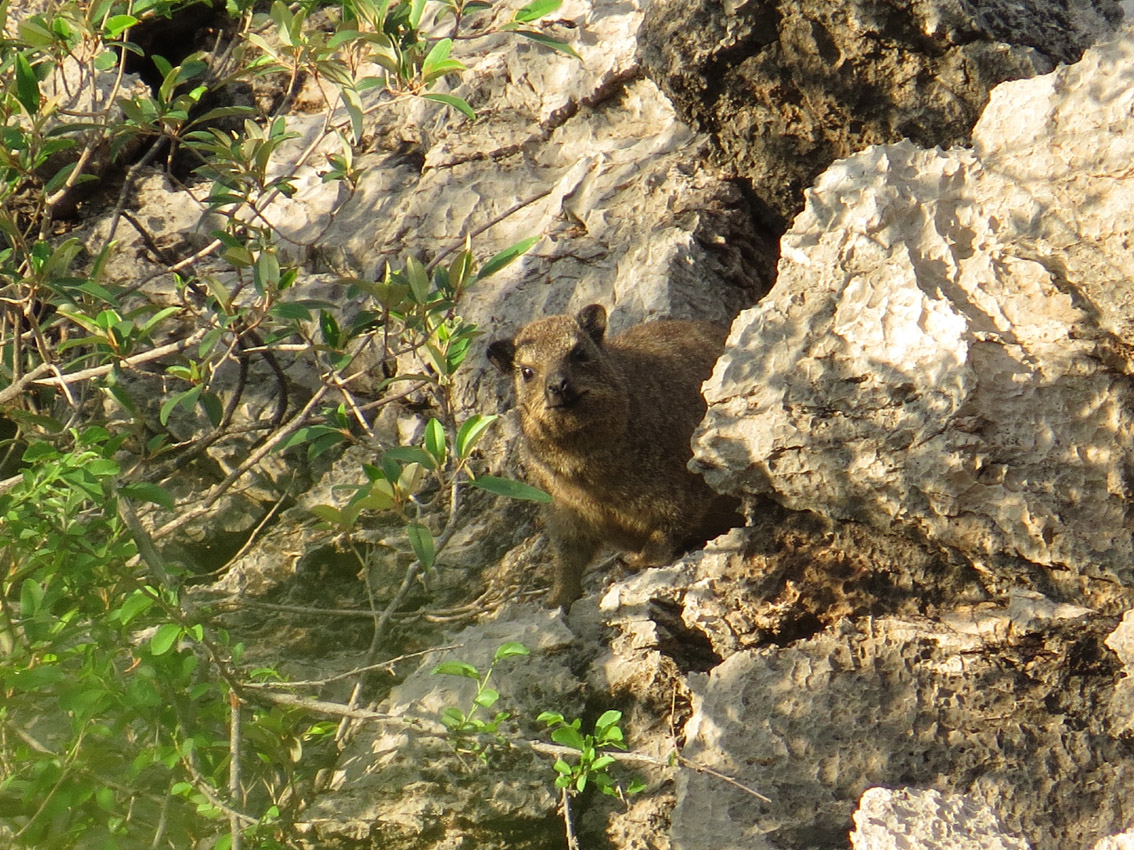
25. Giraffes look down.
Observing impala from the hide, you can see and hear the most unusual things. For example, face a herd of giraffes who decide to eat leaves from acacia, under which the researcher hid. The branches of acacia hang to the ground, so that giraffes do not see the explorer in the thick of the branches and understand that a person is sitting under a tree, only going close to the tree. Realizing that there is someone under the tree, the giraffes begin loudly ... hiss!
Alarm calls of giraffes when observer is detected Giraffa_camelopardalis1_alarm.wav
(Sound hiss and snort).
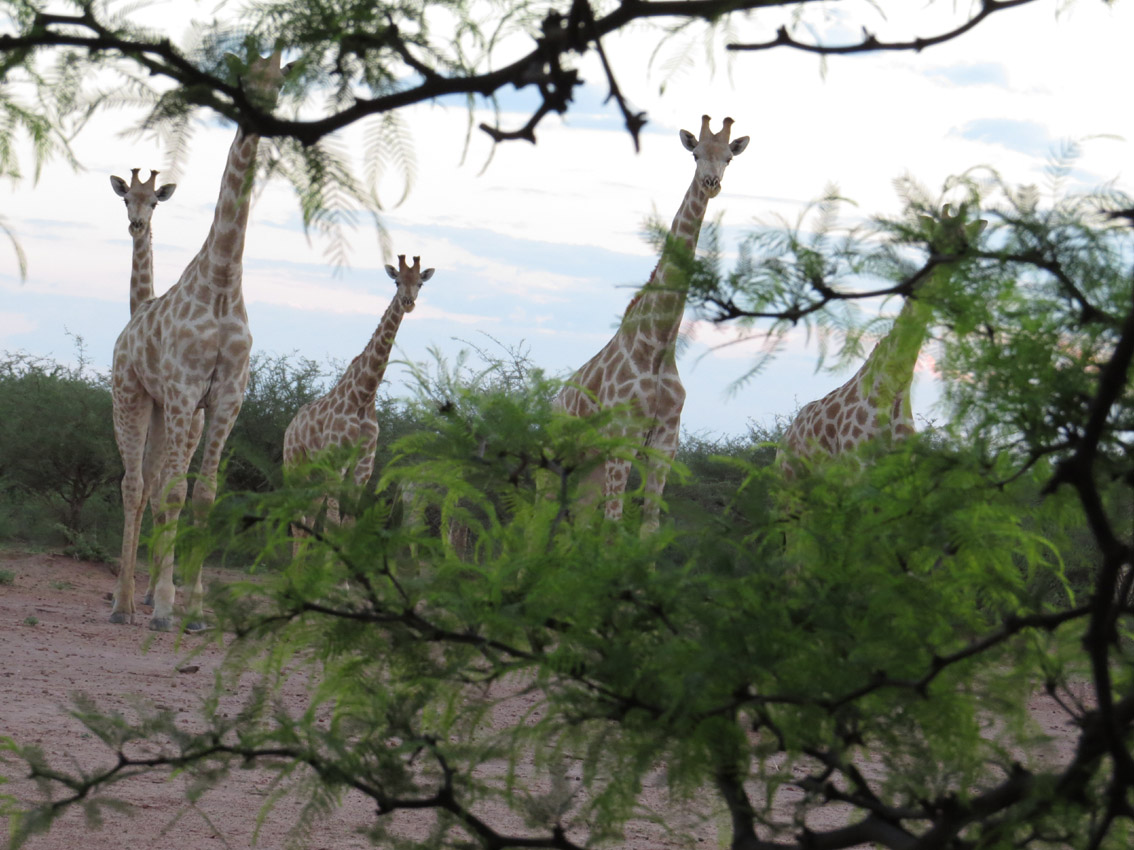
26. Researcher and tree
The sounds of giraffes were recorded under this tree. And the fact that the researcher was wearing a t-shirt with a giraffe was a mere coincidence!
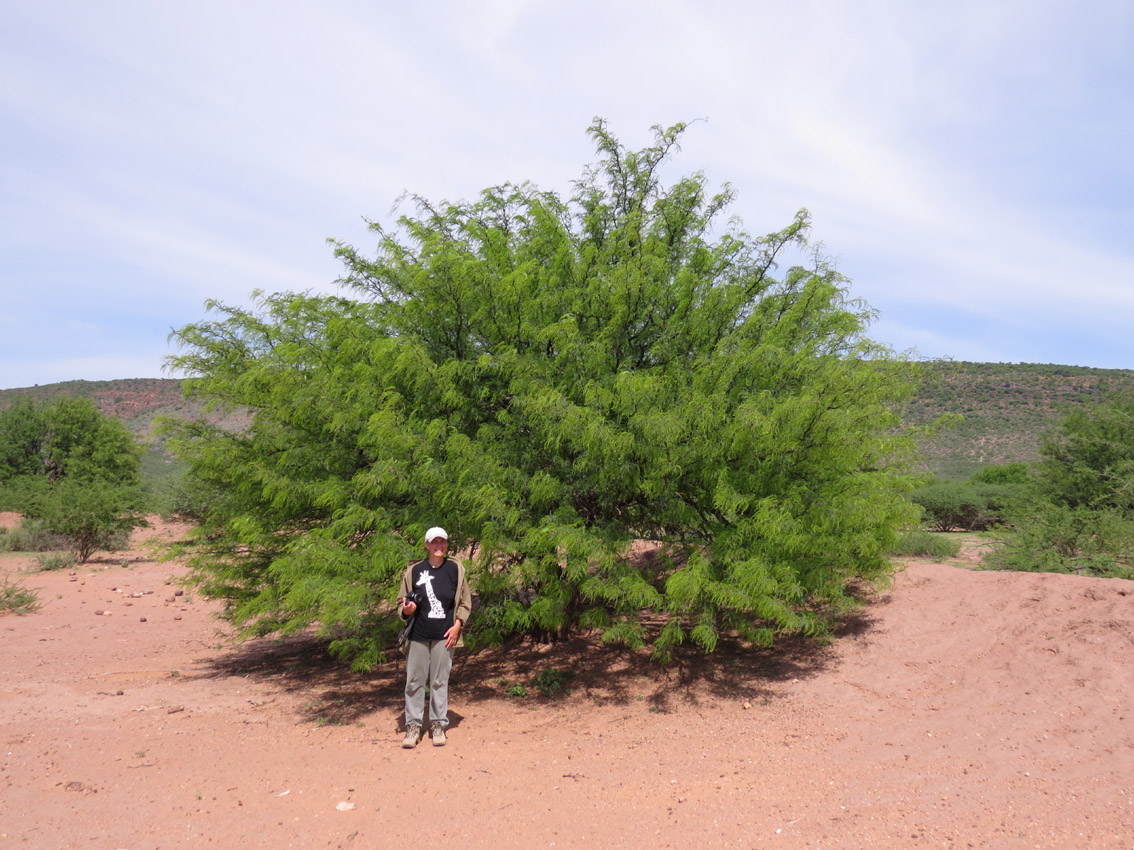
27. Southern masked weaver nest.
With the first rains, weavers begin to twist nests from grass. Nests are located at the very tips of thin branches, often also above a pond. Such a nest suspension is a good protection against predators that cannot stay on thin branches.
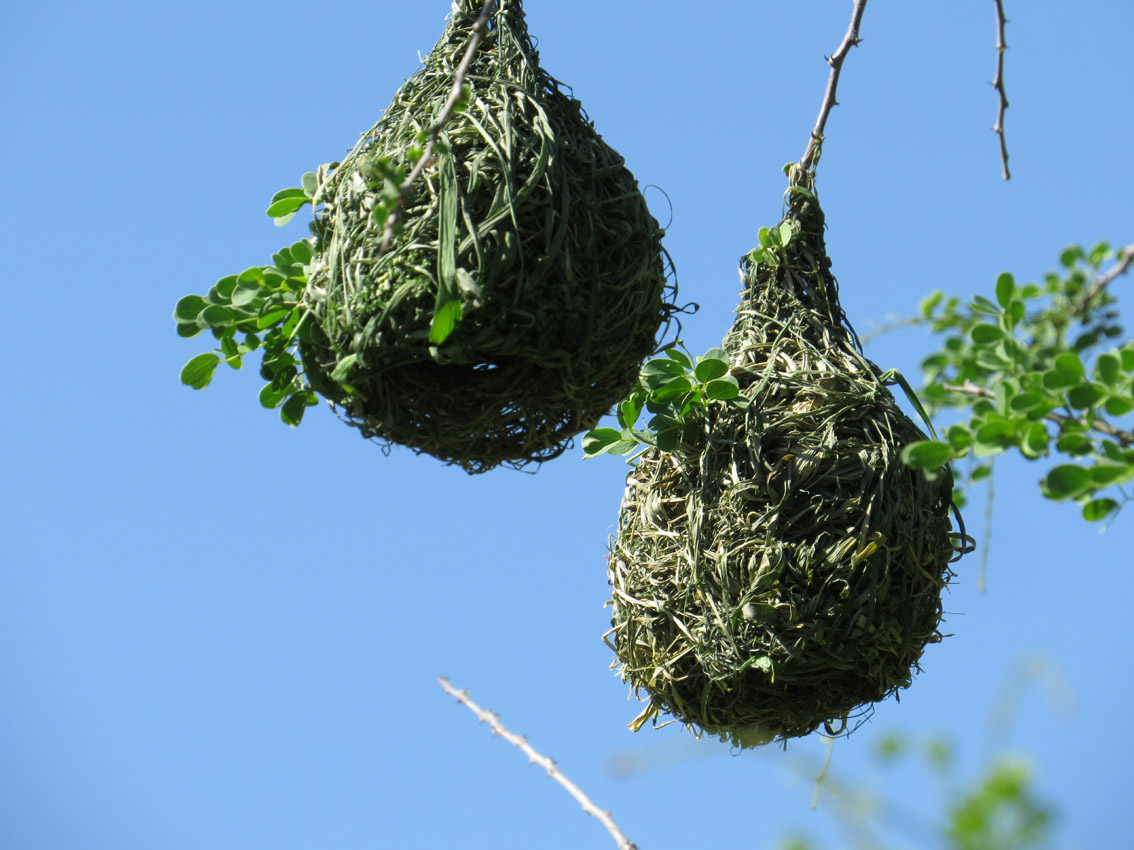
28. Southern masked weaver Ploceus velatus.
This is the southern mask weaver himself.
Rhythmic song of a bird on the tree near the nest.
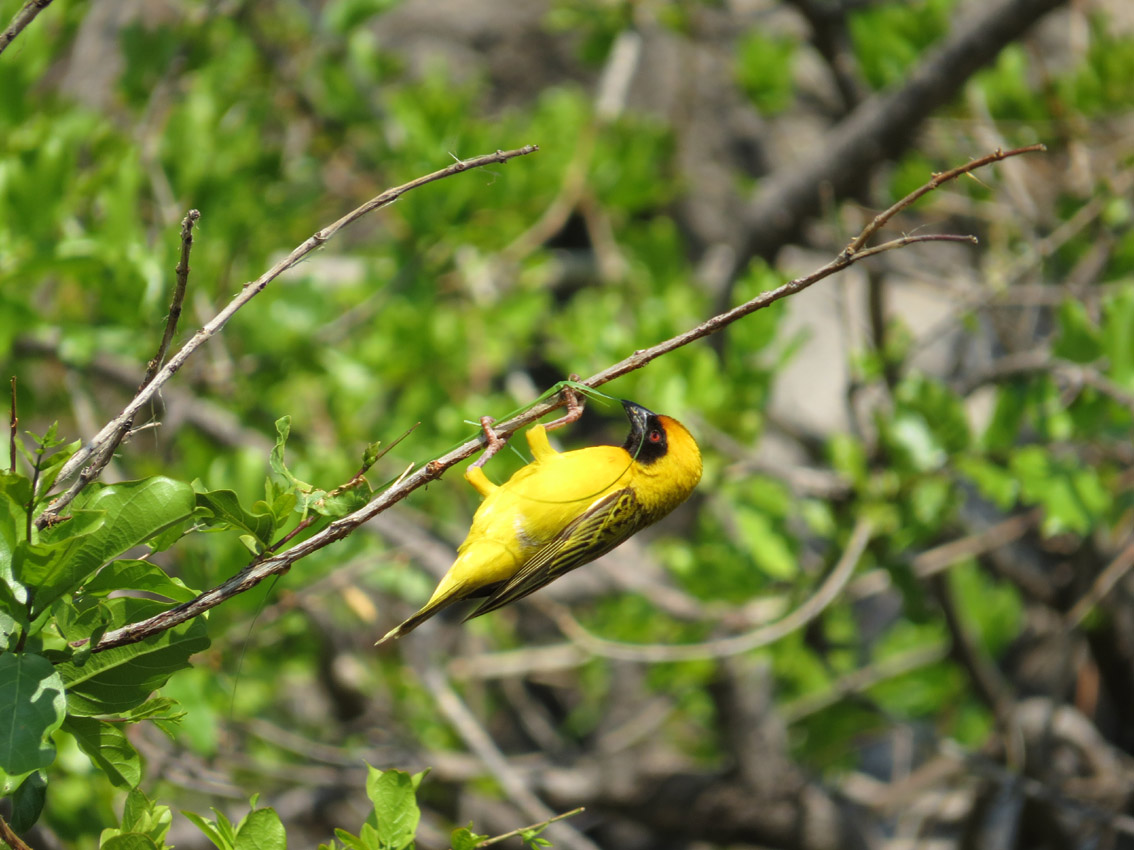
29. Chestnut weaver Ploceus rubiginosus.
The chestnut weaver prefers to nest in large groups, literally clinging to small trees with their nests. This is another way of protecting against predators - try to cope with several dozen angry parents at the same time!
Adult bird singing on a bush with nests.
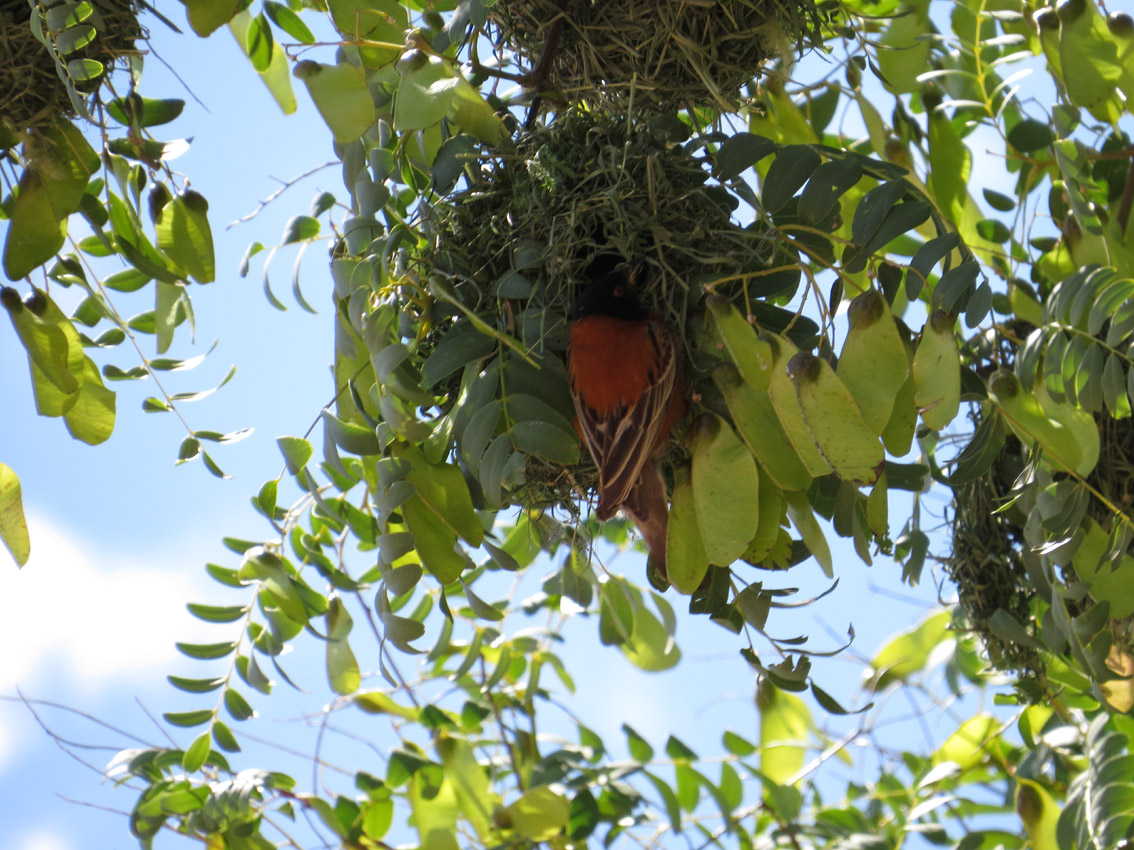
30. Red-billed buffalo-weaver Bubalornis niger.
And the black buffalo weaver comes even more radically. He makes ball nests on prickly acacias. And from prickly acacia branches. hese weavers often settle near farms, for which they got their name.Call up of two birds near the nest.
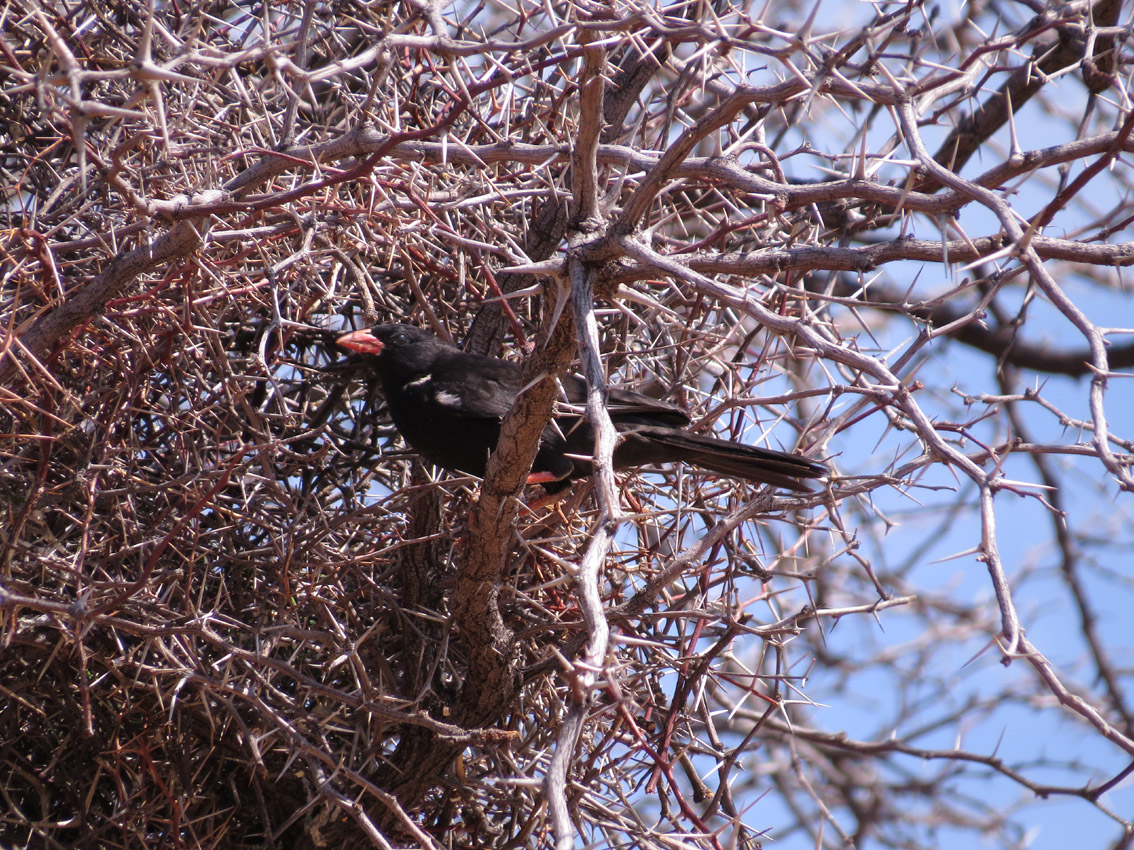
31. Shaft-tailed whydah Vidua regia.
Whydahs are nest parasites. They themselves do not build nests and do not raise chicks. Astrilds and amadines do it for them. Unlike cuckoos, whydah chicks do not throw host eggs and grow in flocks of adoptive brothers and sisters. Remembering their calls and habits, to successfully lay the eggs to their nests in the future.
The male sings on top of the bush, changing the types of songs.
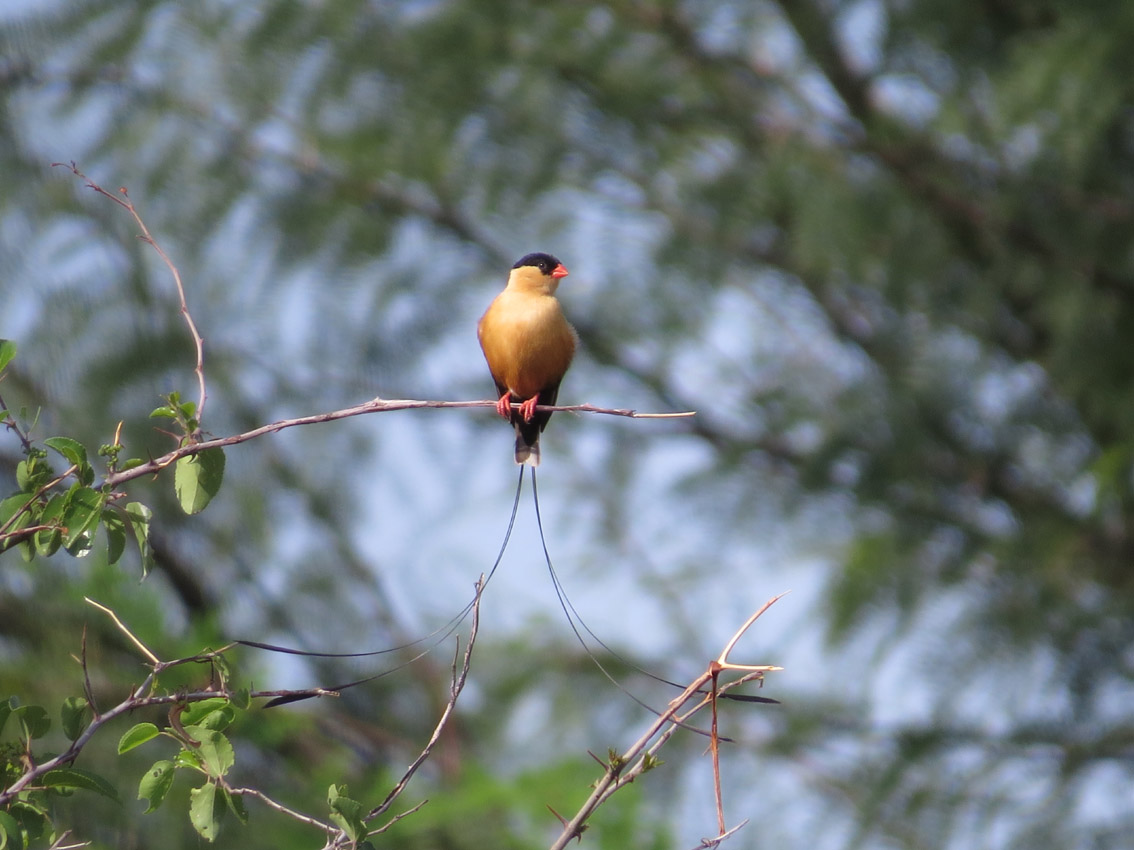
32. The violet-eared waxbill Uraeginthus granatinus
The violet-eared waxbill, in whose nests the royal whydahs lay their eggs.
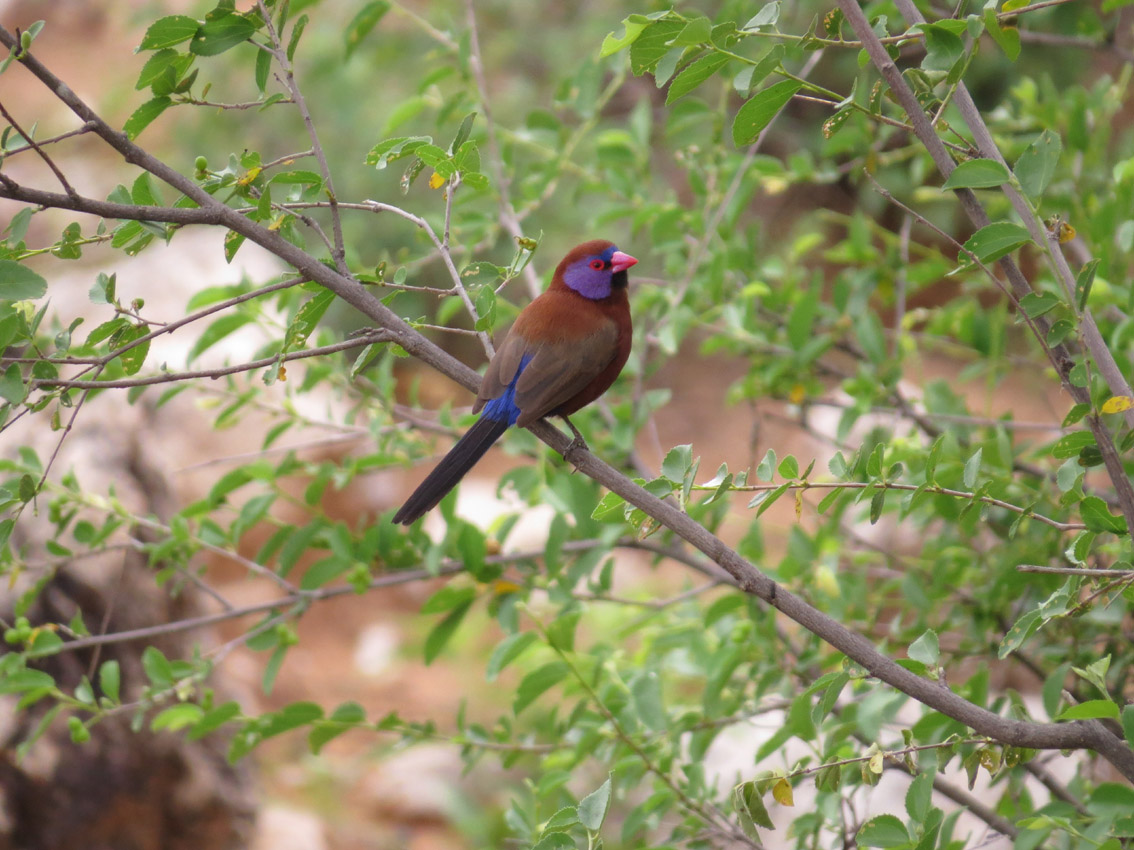
33. Kori bustard Ardeotis kori.
Kori bustard is a large bird with strong legs. So, it prefers walking although it flies well too.
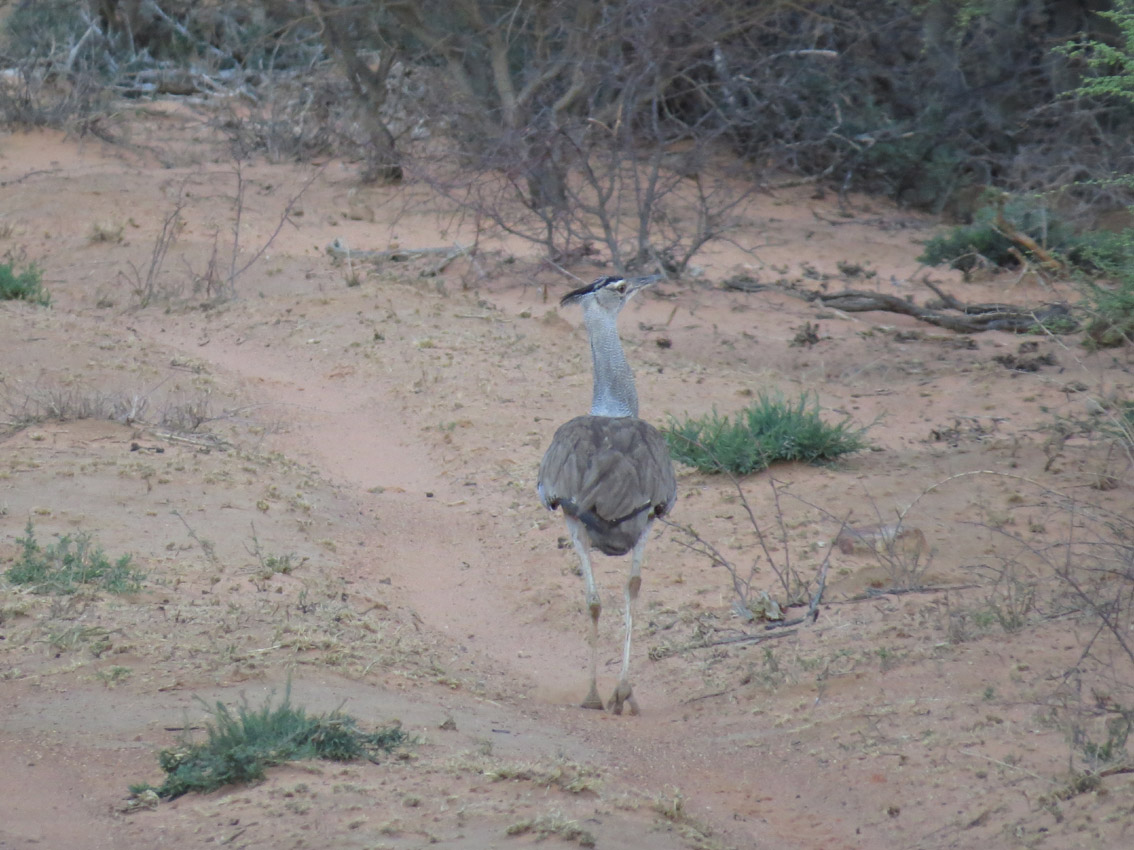
34. Orange River francolin Scleroptila levaillantoides.
Another land bird is Orange River francolin. What a name! You immediately realize that you are in Africa!
A pair of birds duetting during a courtship display, approaching time to time to each other with lowered wings
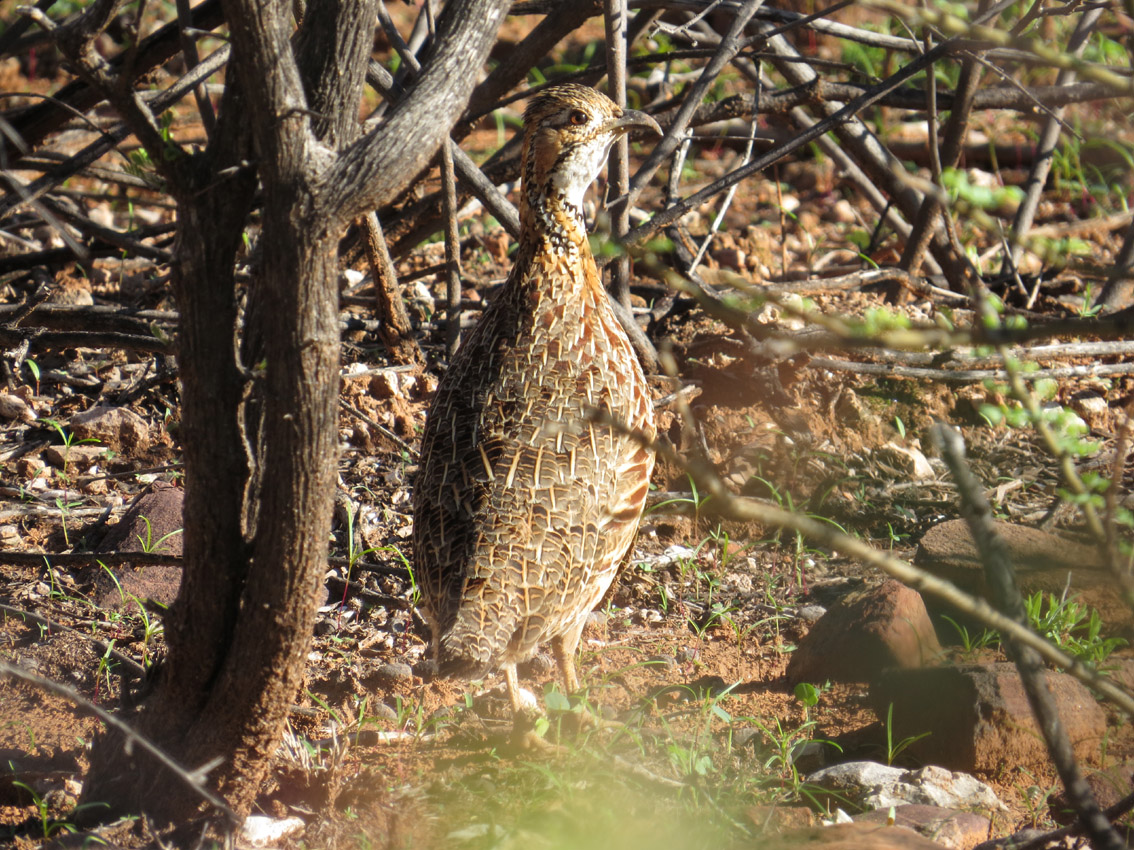
35. Impala among bushes.
But let's return back to impala from those animals that we managed to observe while we expected impala. Impals live in very thorny bush and feed on it. Unclear how they manage not to be scratched by them. But, when a couple of T-shirts was completely destroyed by the thorns, we learned to walk as carefully as impala, without touching the bushes.
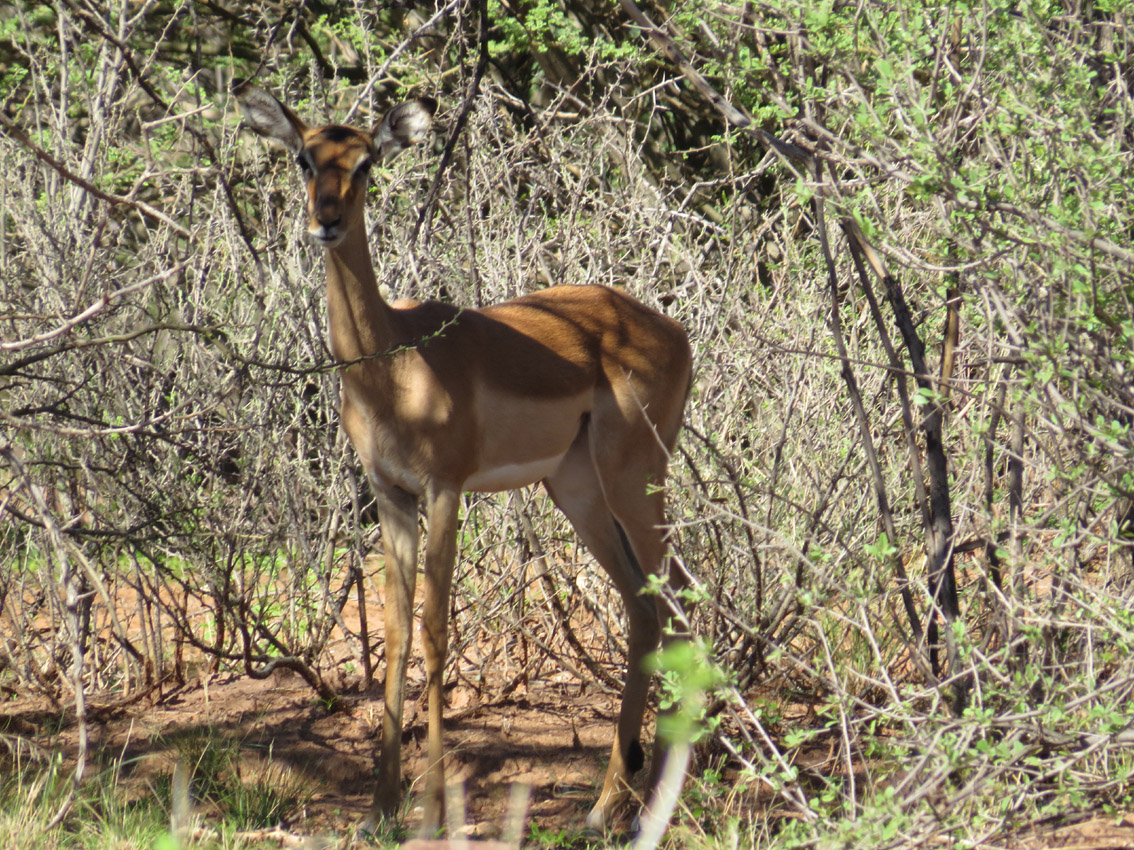
36. Female impala
Most of the time, females with young graze on the slopes of stony hills, where they are poorly visible among the bushes. Their routes vary from day to day so that the grass has time to grow between visits to the same places, but a noticeable network of paths indicates the regularity of visits to the grazing places. On such impala paths leopards lie in waiting for their victims.
Sound Contact calls of several impala females; a small group is walking along the road past the observer, several females vocalize
Three contact calls of one impala young, looking for its predated mother
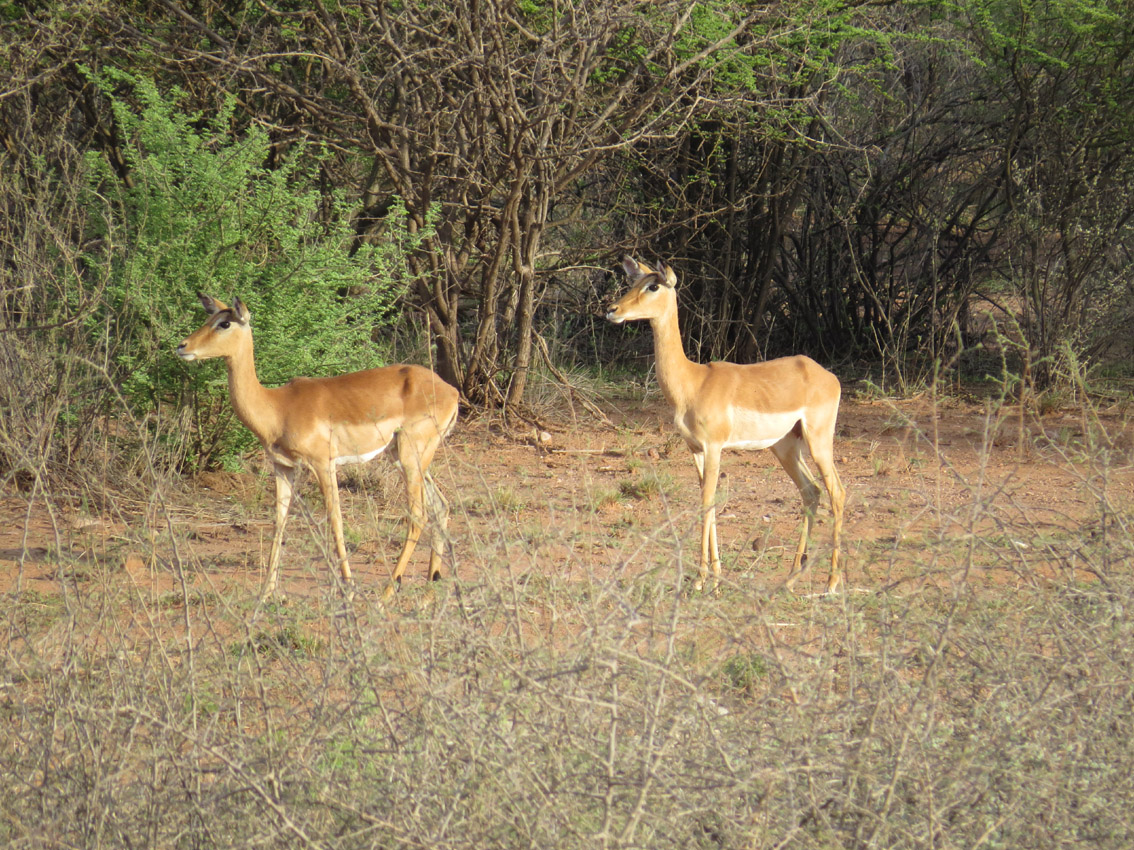
37. Male impala.
Mature impala males, as a rule, do not walk with females, but keep in small groups with other males or singly. Impala daily move to the mountains and back to the valley, using the passages between the bushes. Many of these passages are suitable for humans. However, often impala use for their movements dry channels of mountain streams, over which spiky branches hang low. Here, even the impala has to bend down. For impala, these channels are attractive, because the bumps of fresh grass are available here even in drought. This male leaved bush before sunset for feeding in the open area.
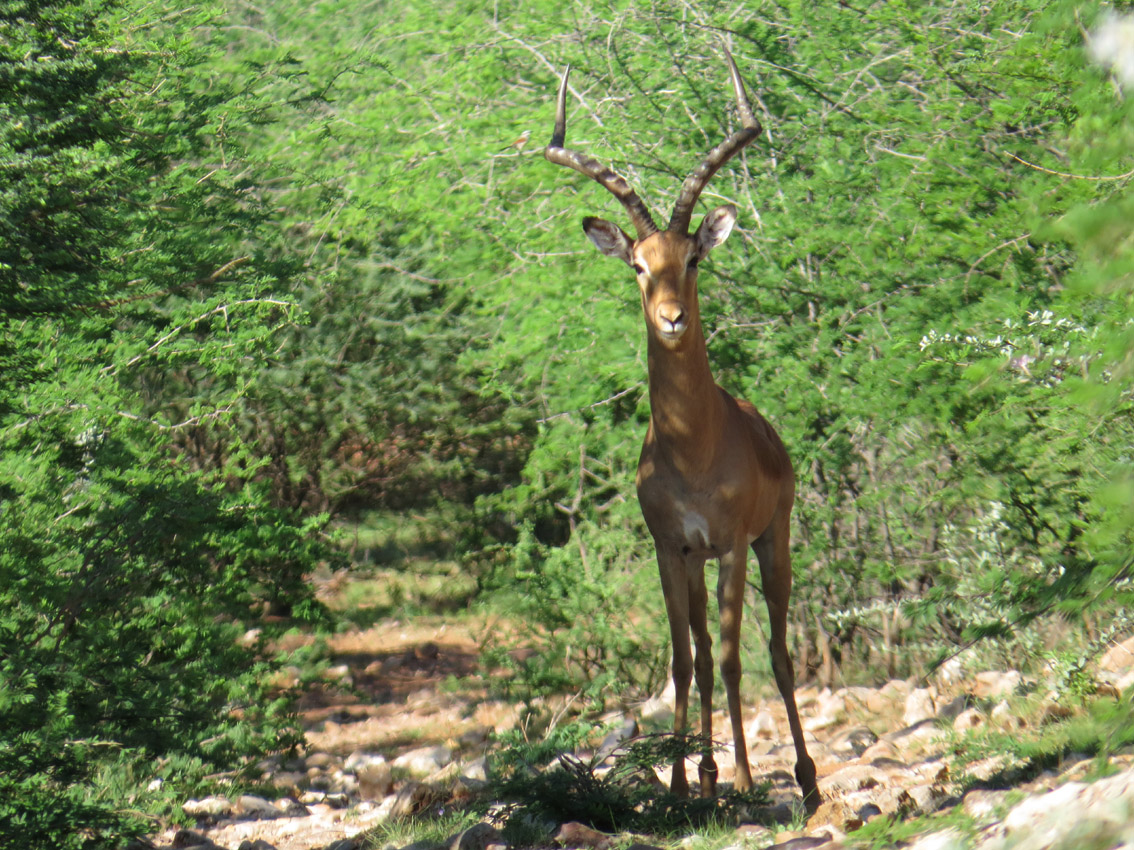
38. Anatomical dissection of a predated impala young.
We found a leopard prey, first an impala cub, and then an adult female. Large cats always begin to eat prey from behind, so the vocal apparatus remained intact. This is a good lack, because we need anatomical samples for measurements female and offspring larynx and vocal tract. Dissection is a time and labor consuming process that in the field takes two to three days. To preserve the specimen from drying, it is covered by a wet cotton, and only a small part is opened for dissecting.
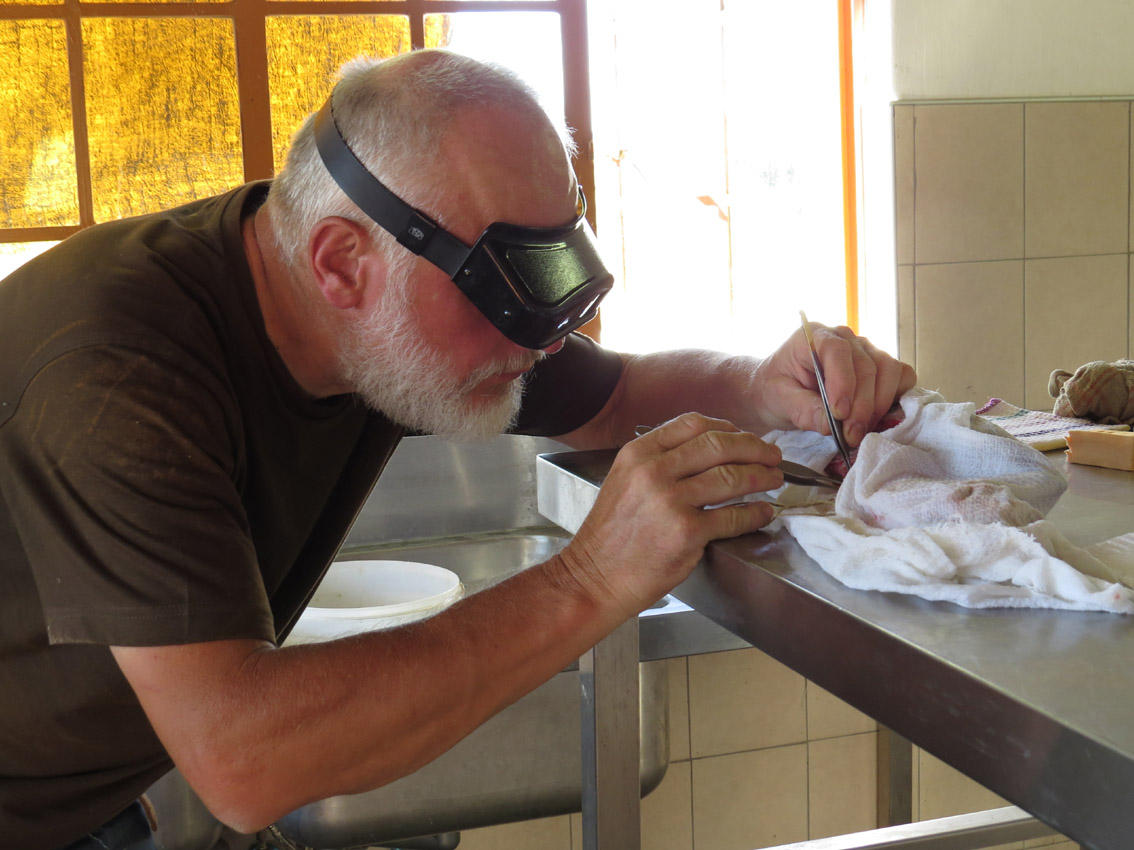
39. Female kudu spotted a researcher.
If a researcher well-masked in the hide, then even the most cautious of the antelopes, the kudu females, will come up to you at 20 m, trying to understand what is there under the bush.
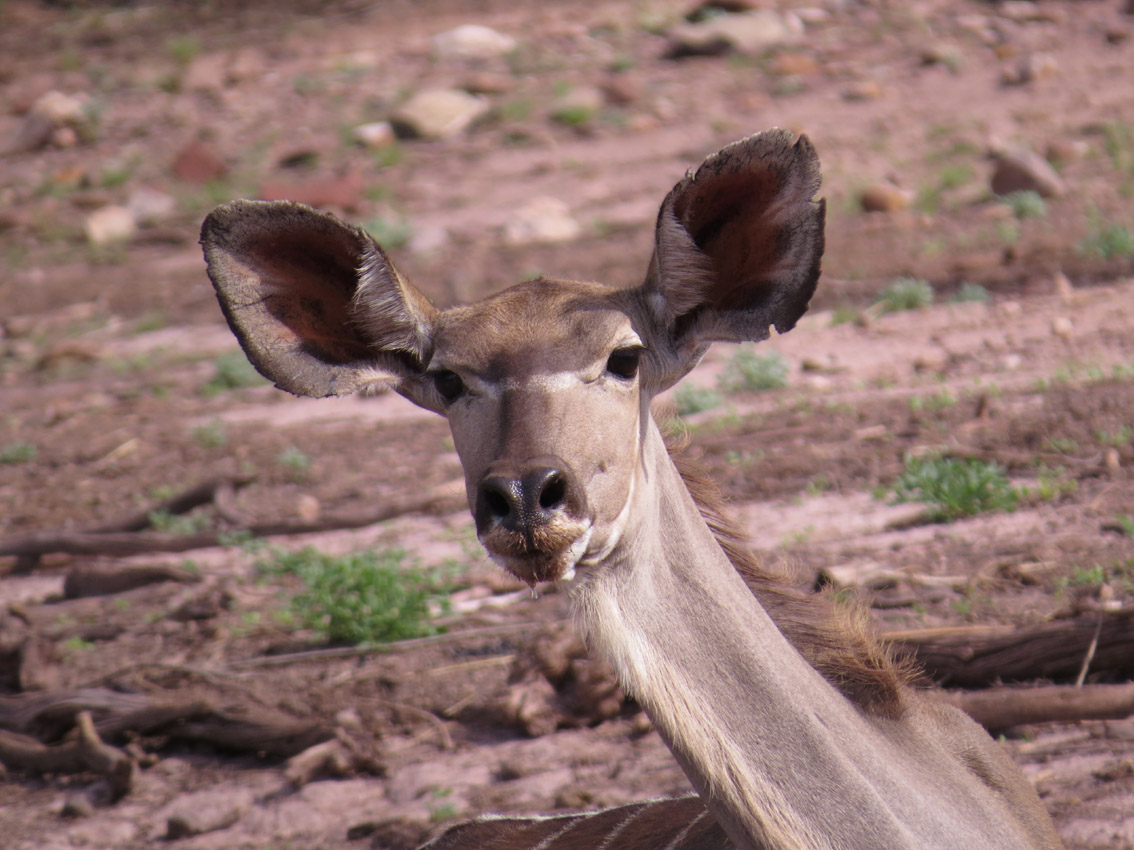
40. Springbok antelopes.
A group of springboks grazes in the evening in a large open space, the size of a football field. While antelope young are small, hunting is closed, and springboks seem to know about it because they do not run away from people and cars, as they usually did in May.
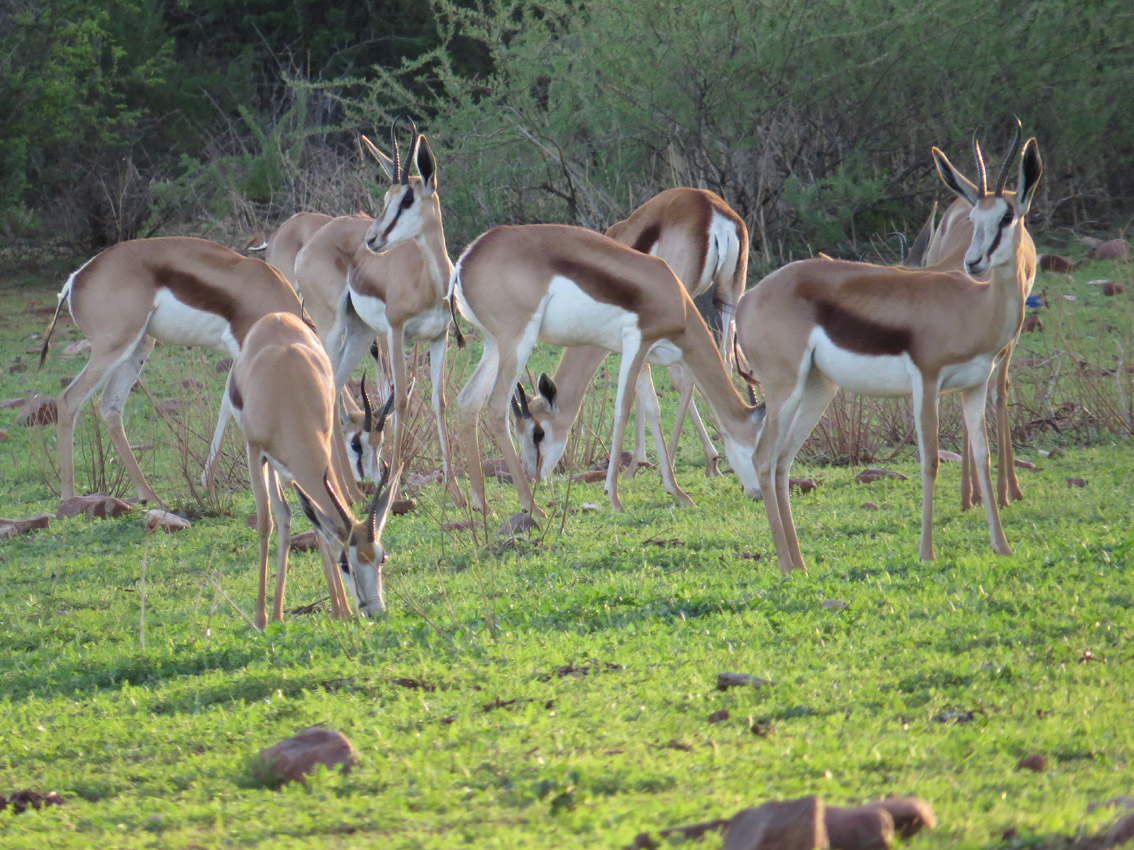
41. Canna antelope with young.
Before the rainy season, many species of mammals deliver the young. This calf is still feeding on milk. A little later, the grass will grow, and the young will feed also on grass.
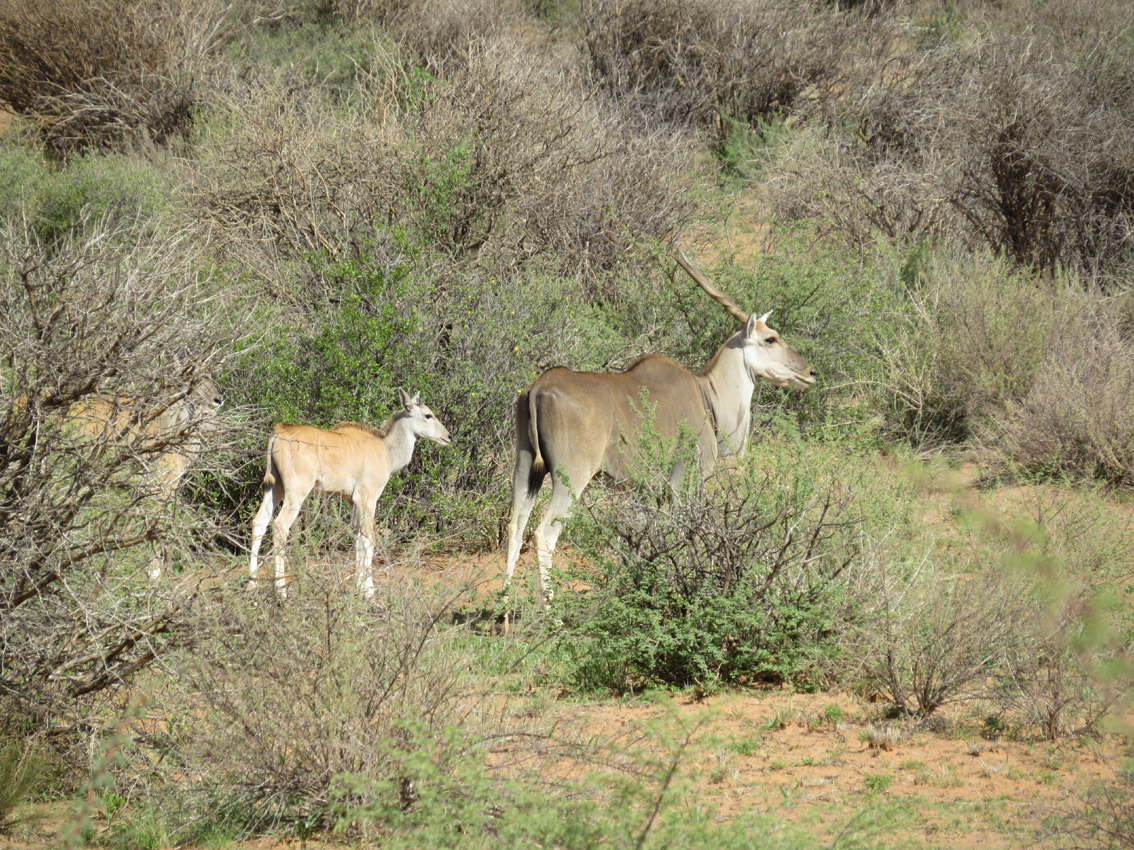
42. White rhinos.
In rhinos, two females of five have the young. So, the rhinos became very aggressive, and a few times tried to attack our car. We were happy to notice them earlier than they noticed us.
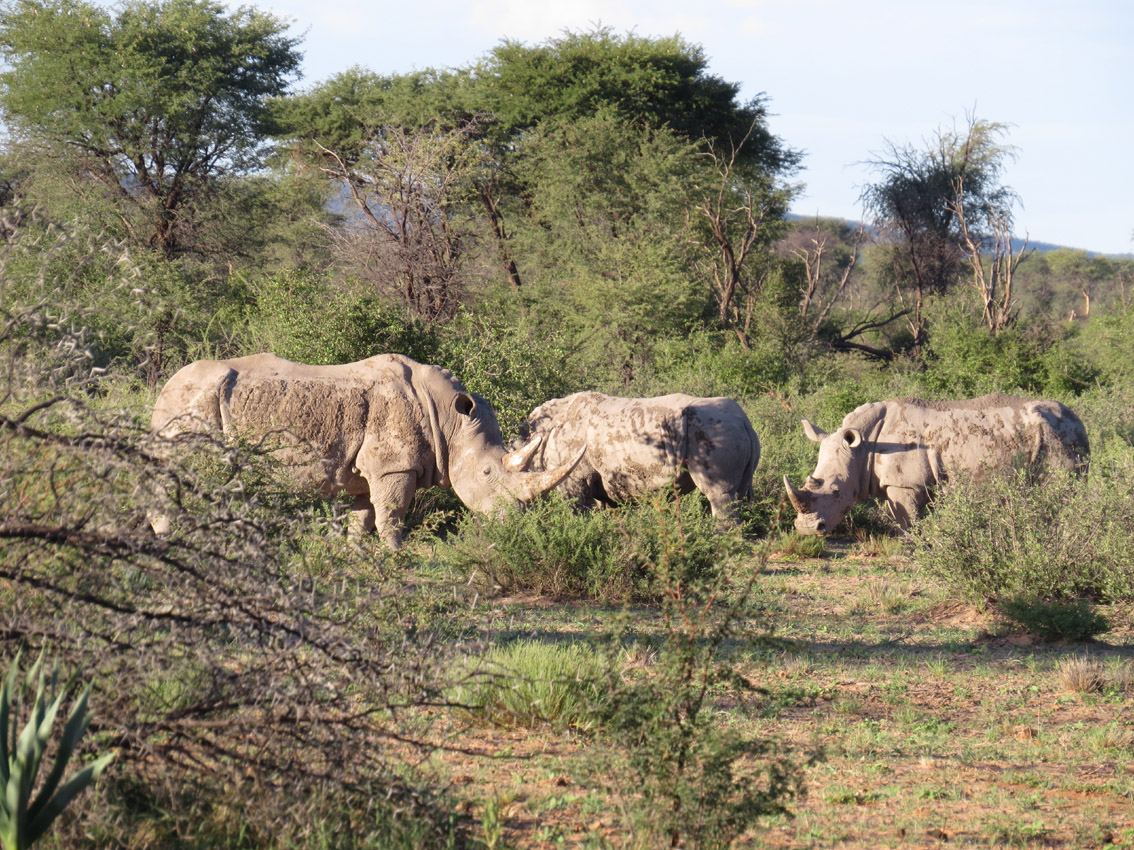
43. Male cow antelope.
The rains ended, the water became less, and again it became the most effective to watch animals at watering places. Male cow antelope is a rare guest.
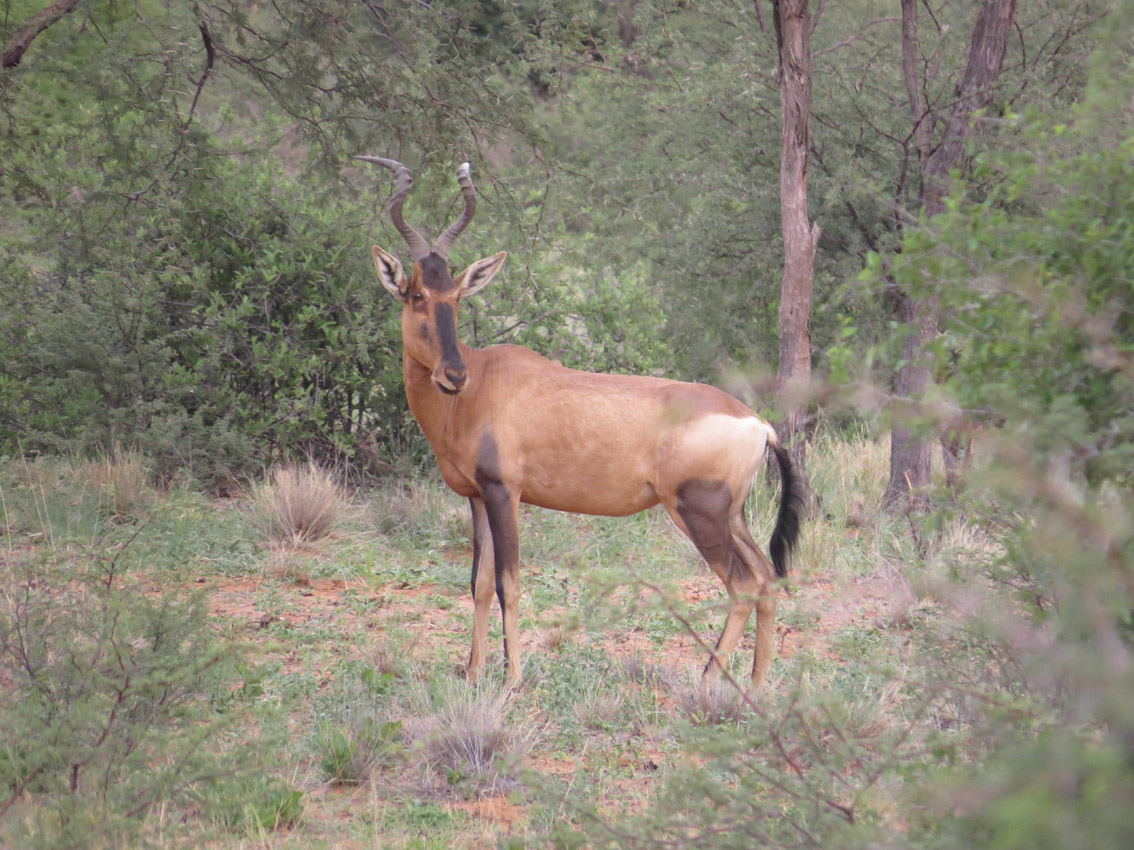
44. Male sable antelope.
Male sable antelope. And really the name is speaking.
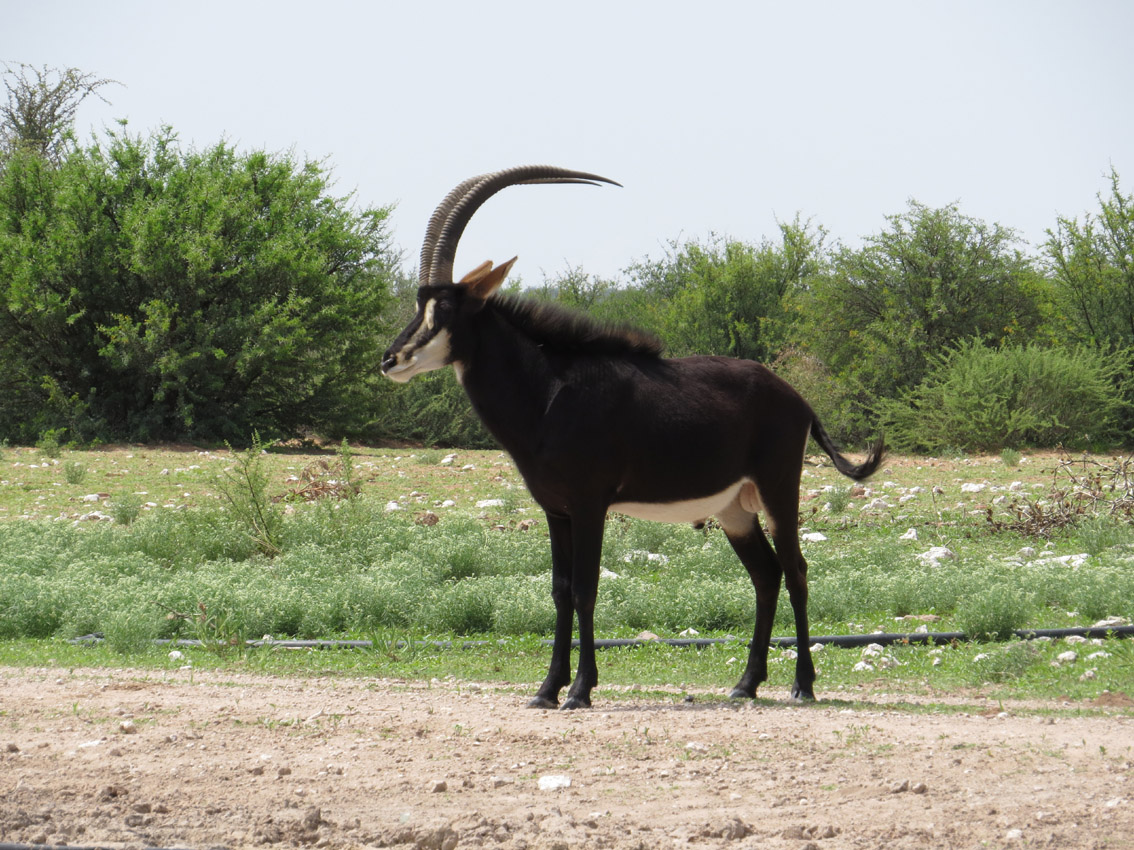
45. Mountain zebra.
Mountain zebra goes uphill after drinking water. Unlike plain zebras, the mountain zebras have only two colors, black and white. Intermediate brown strips are lacking.
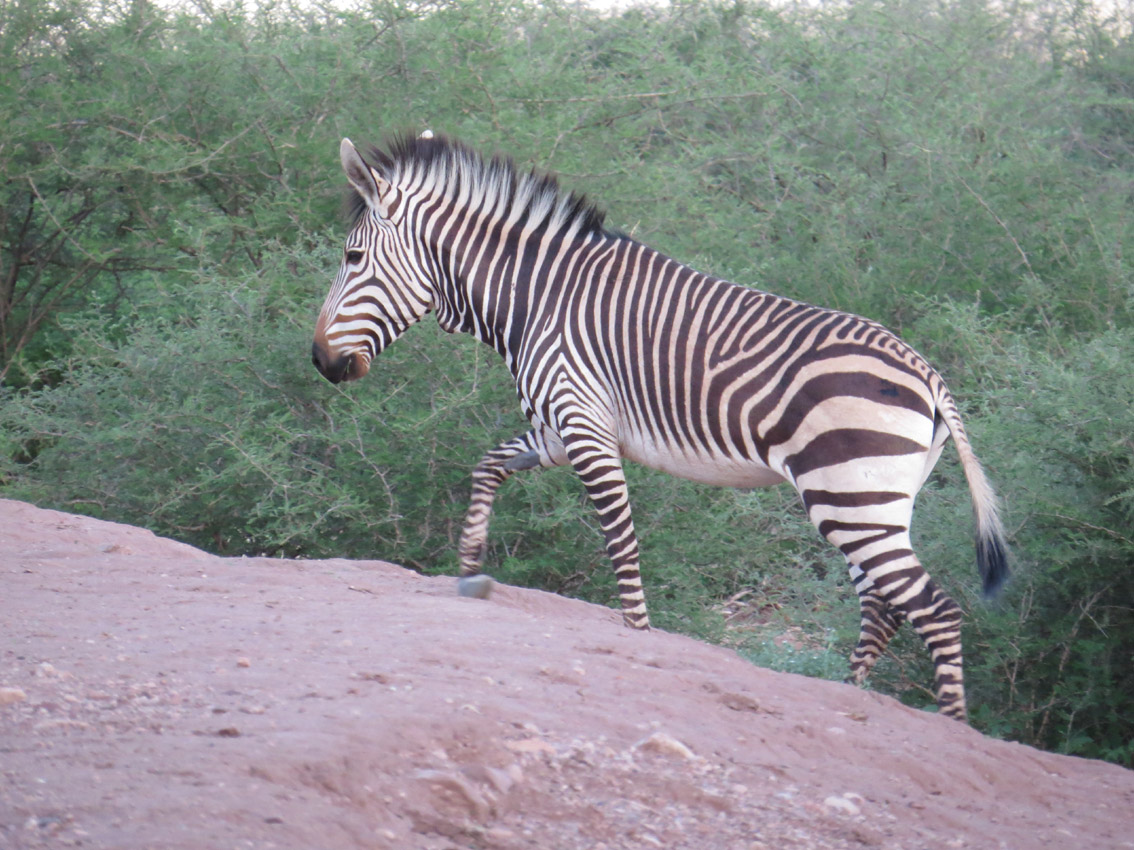
46. Chakma baboon.
Baboons spend almost all the time on the tops of the cliffs, from where they can clearly see the approaching predators. However, twice a day, morning and evening, they have to go down to the ponds for drinking. Where leopards can lie in wait for them. Therefore, while some drink, others guard.
A group of one male and three females shouts at the observer .
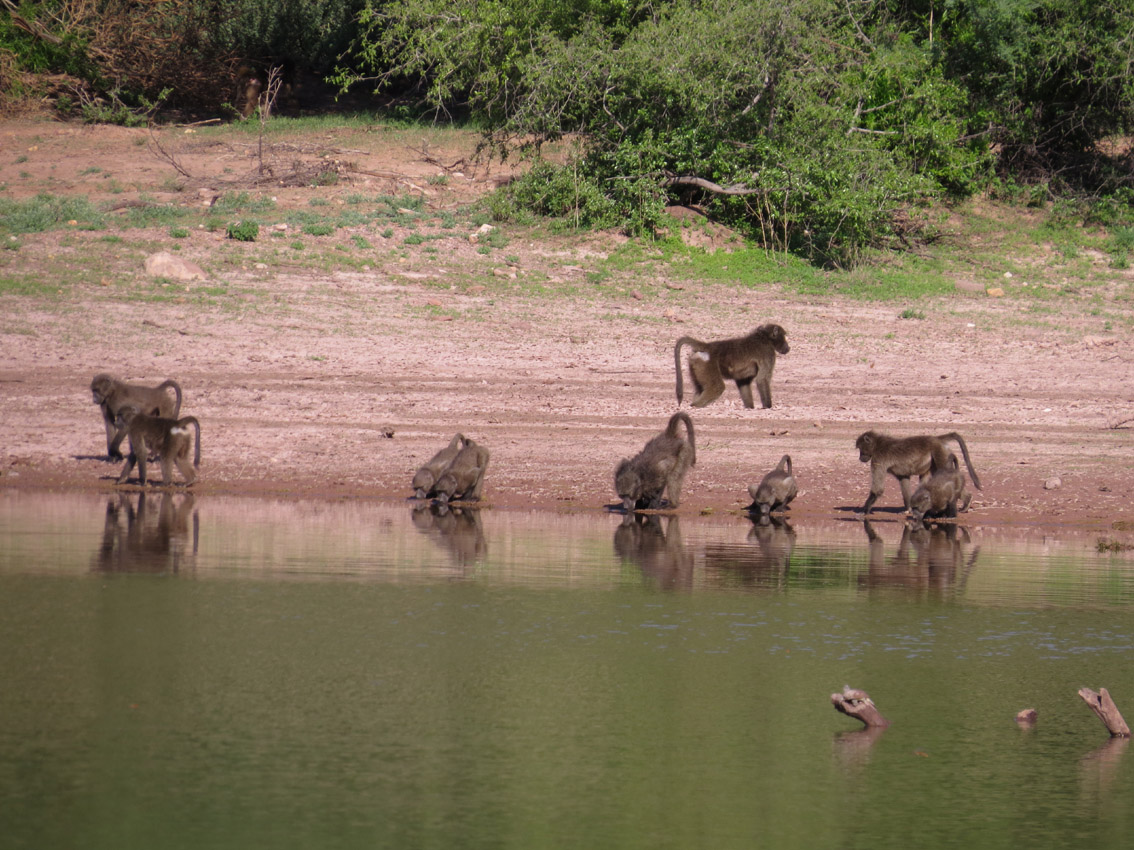
47. Researcher with recorder and camcorder.
Researchers should always have equipment for photographing and recording animal sounds. Every minute something very interesting may appear.

48. Horned locust.
After the rains a lot of insects appeared, unusually large-sized. Flightless locust with amazing "horns" camouflaged to the surrounding area.
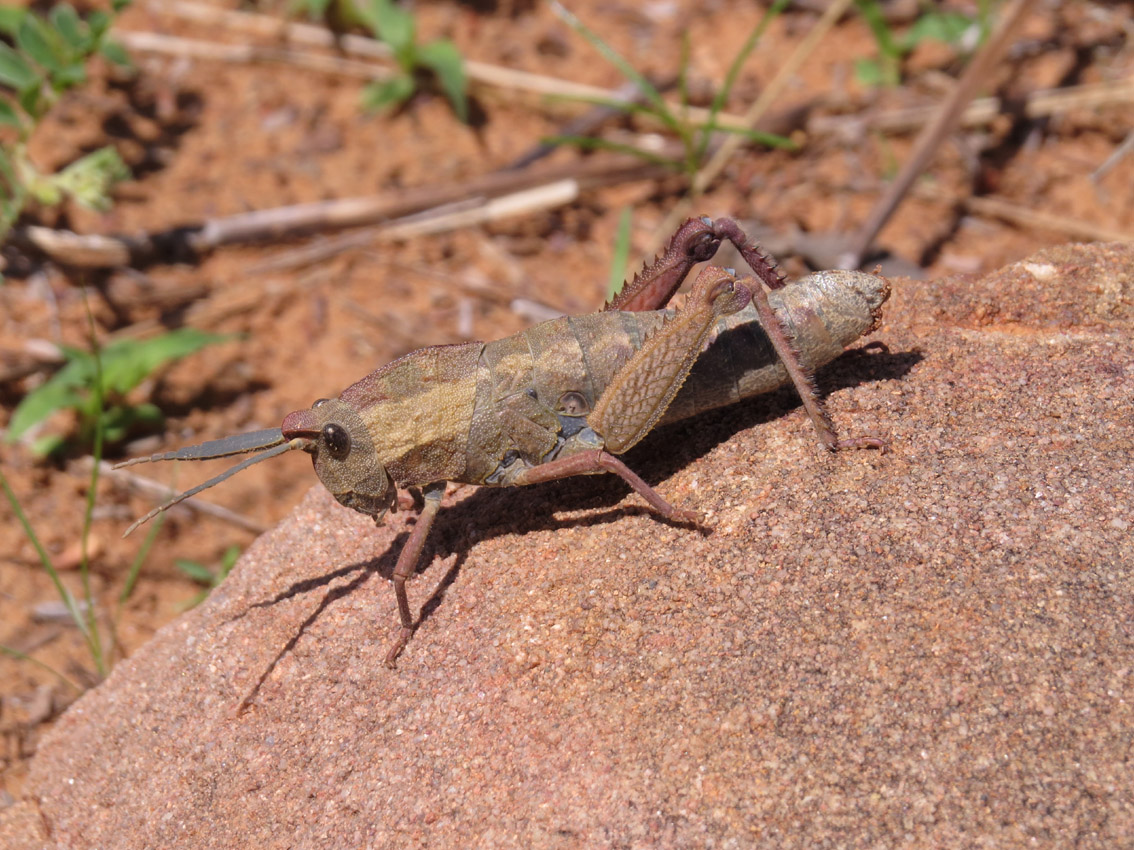
49. Yellow locust.
Other locusts, on the contrary, are very bright and noticeably colored. And hold in groups.
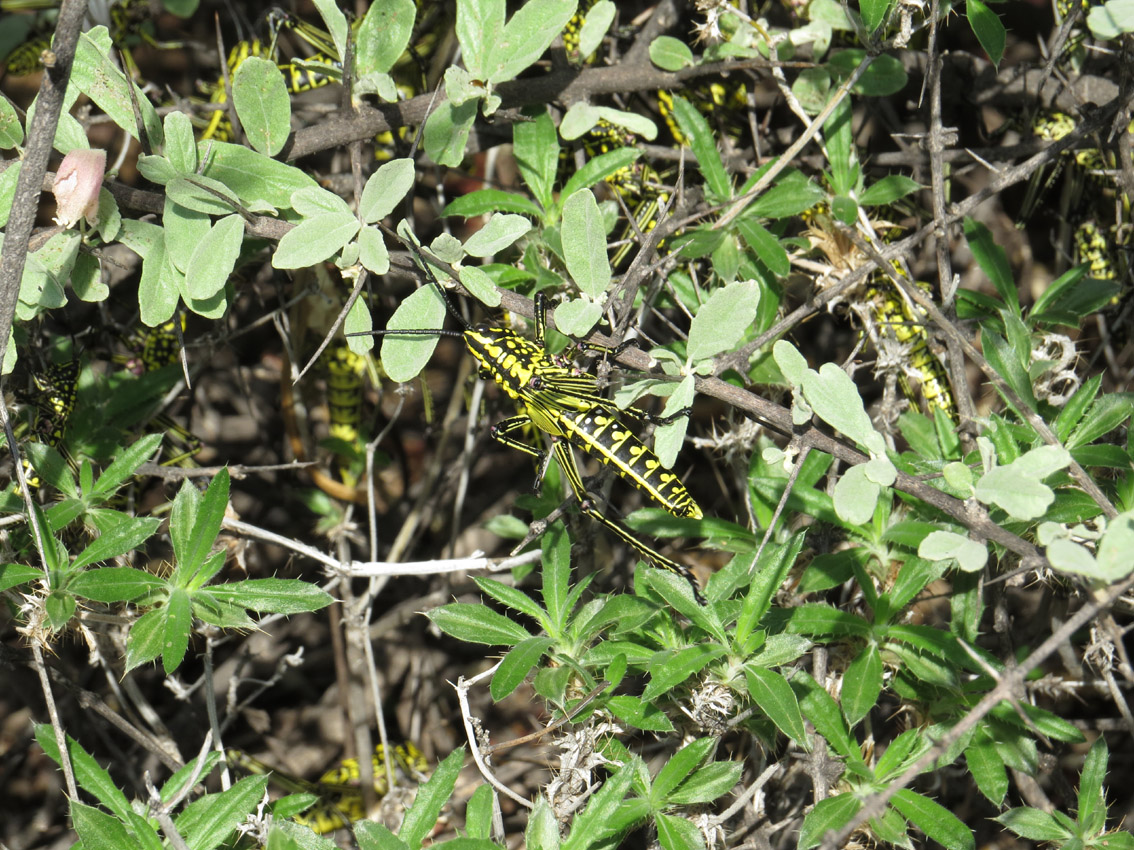
50. Dragonfly.
Each even a small pond is full of life: frogs, dragonflies, butterflies are numerous..
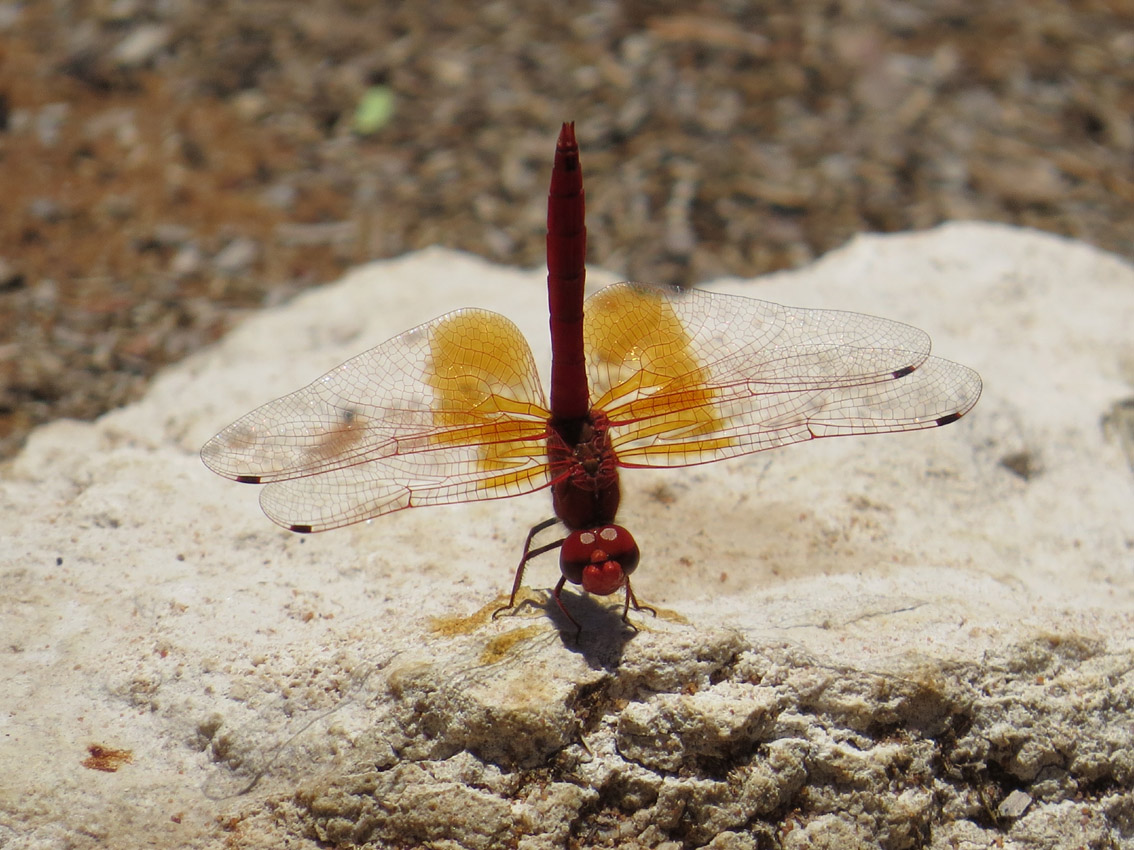
51. Butterflies on moist sand.
In the afternoon, the sun bakes, but the sandy soil around the ponds keeps moisture. Butterflies fly for drinking.
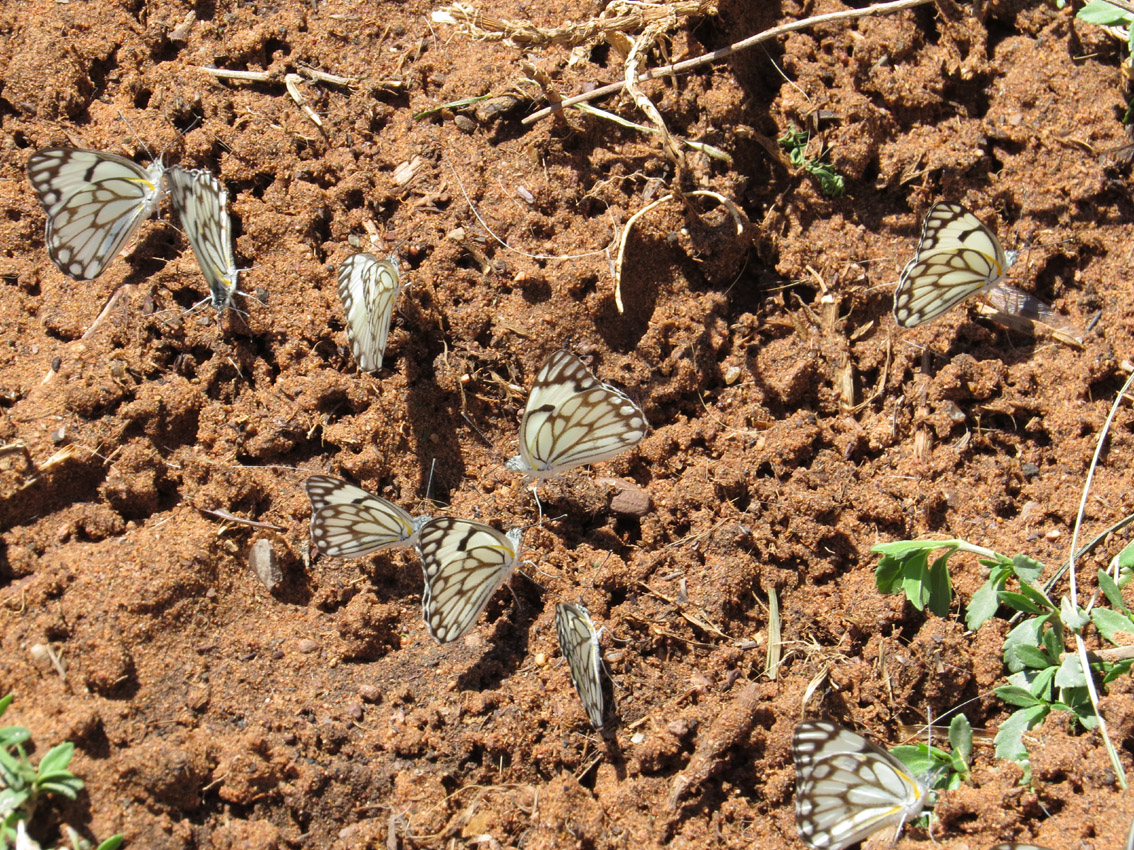
52. Flying insects around the lamp.
In the evening, a myriad of large insects flies into the light of a lamp, and curls around, mistaking it for the moon.
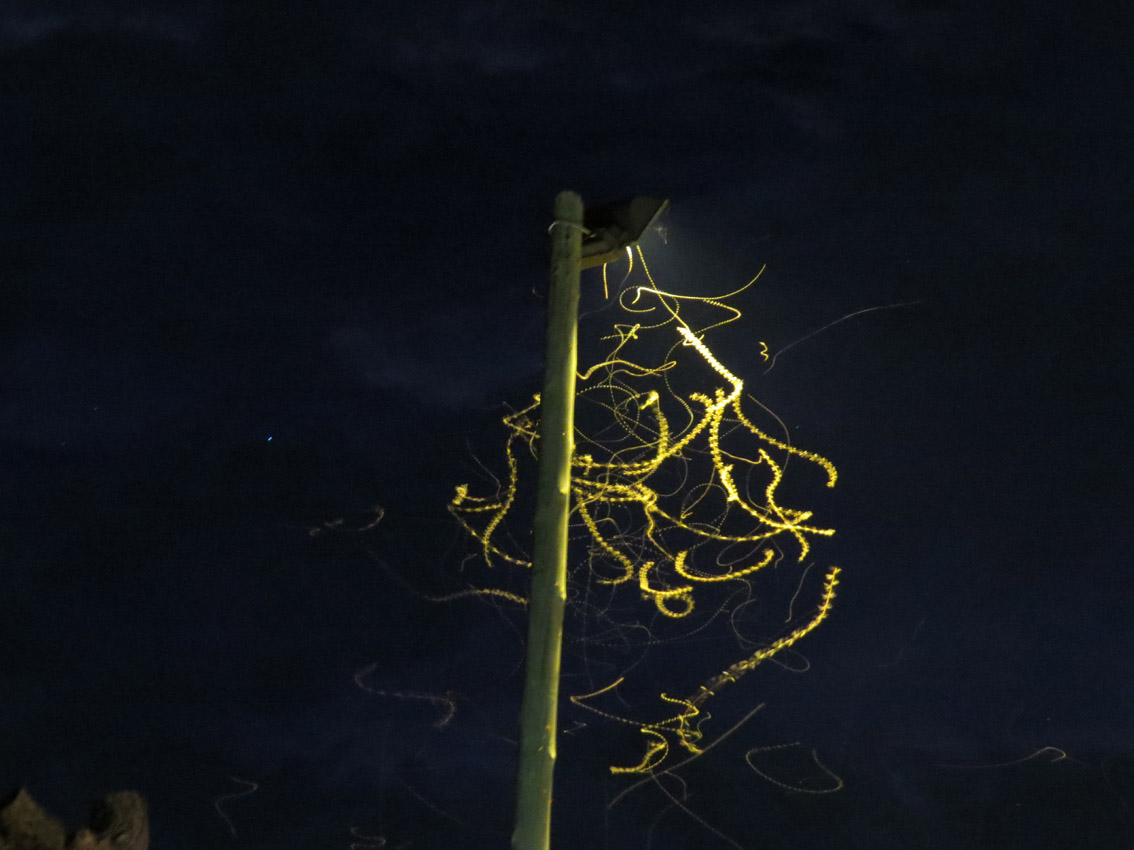
53. Butterflies on an outdoor lamp.
Large night butterflies fly into the light of the lamp and sometimes cover it with a continuous layer.
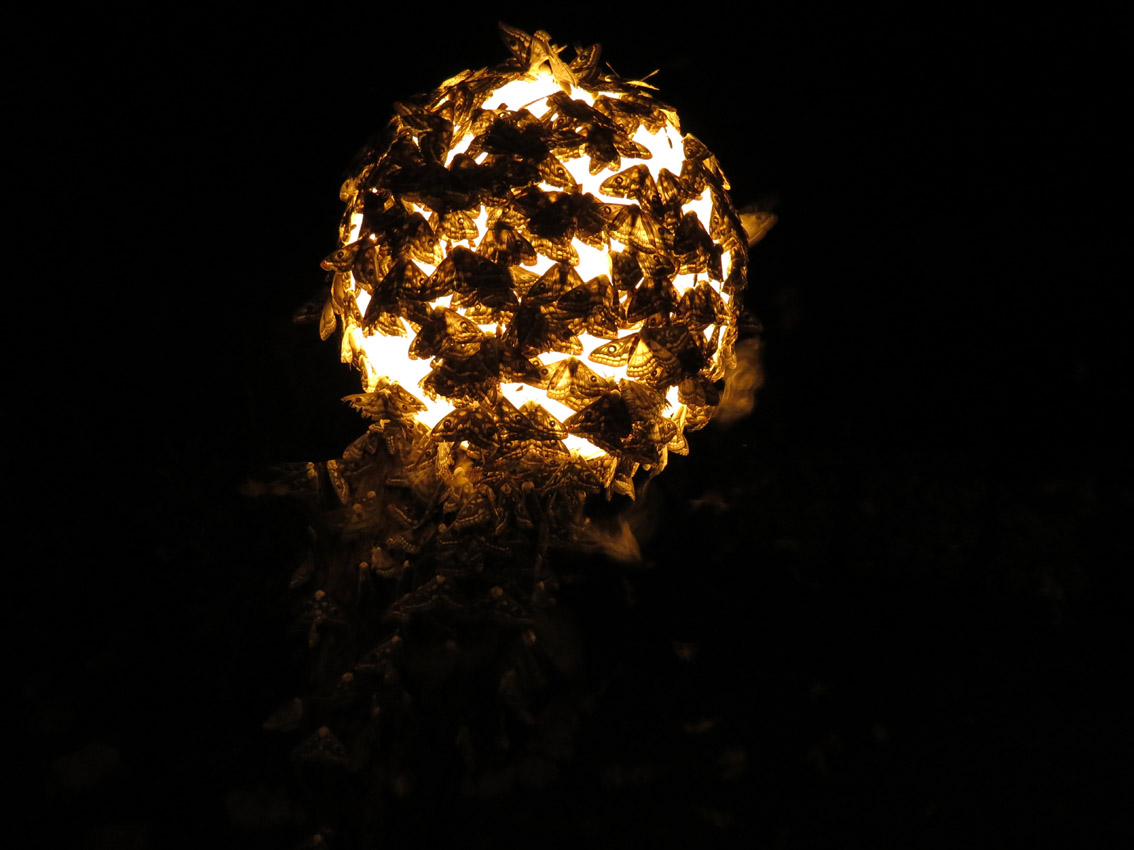
54. Agama.
To lizards, on the contrary, hot weather is only a plus. The sun rose high, and the agama warmed up after a cool night goes hunting
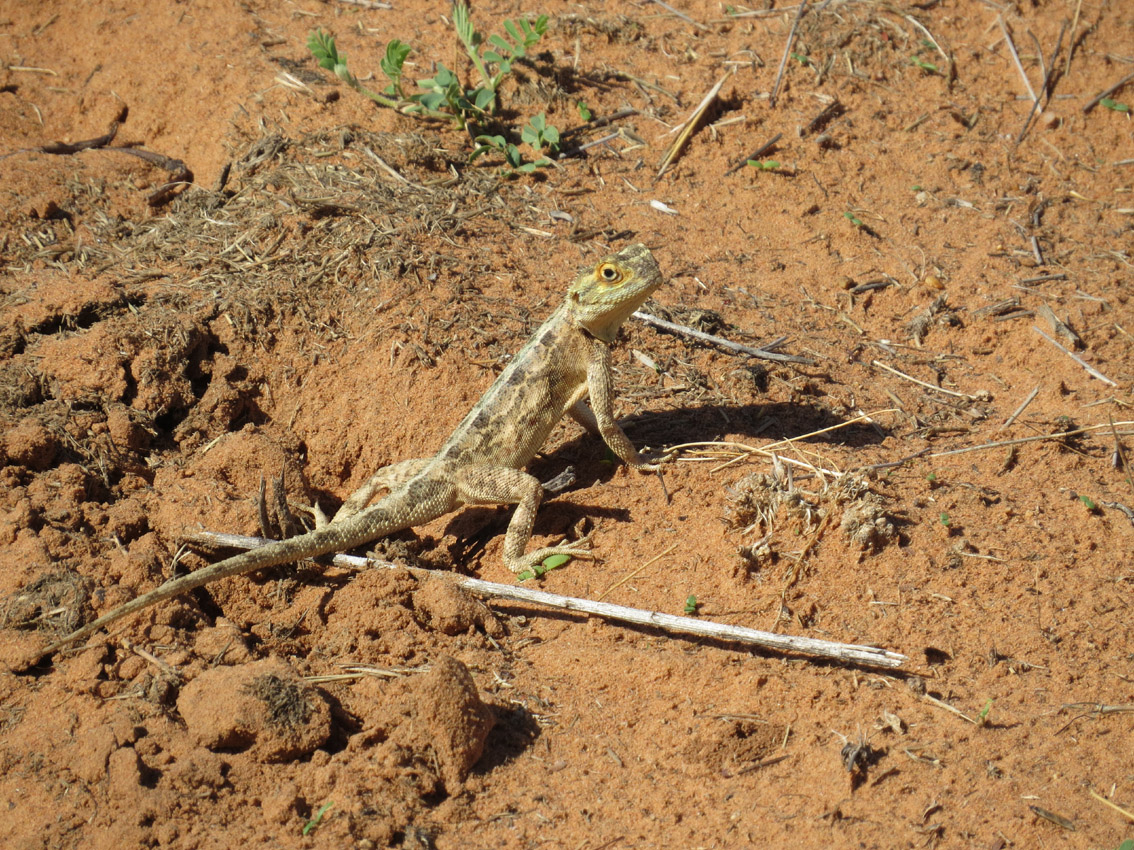
55. Sandy painted lizard.
This lizard preys on ants, quickly catching them and swallowing one by one.
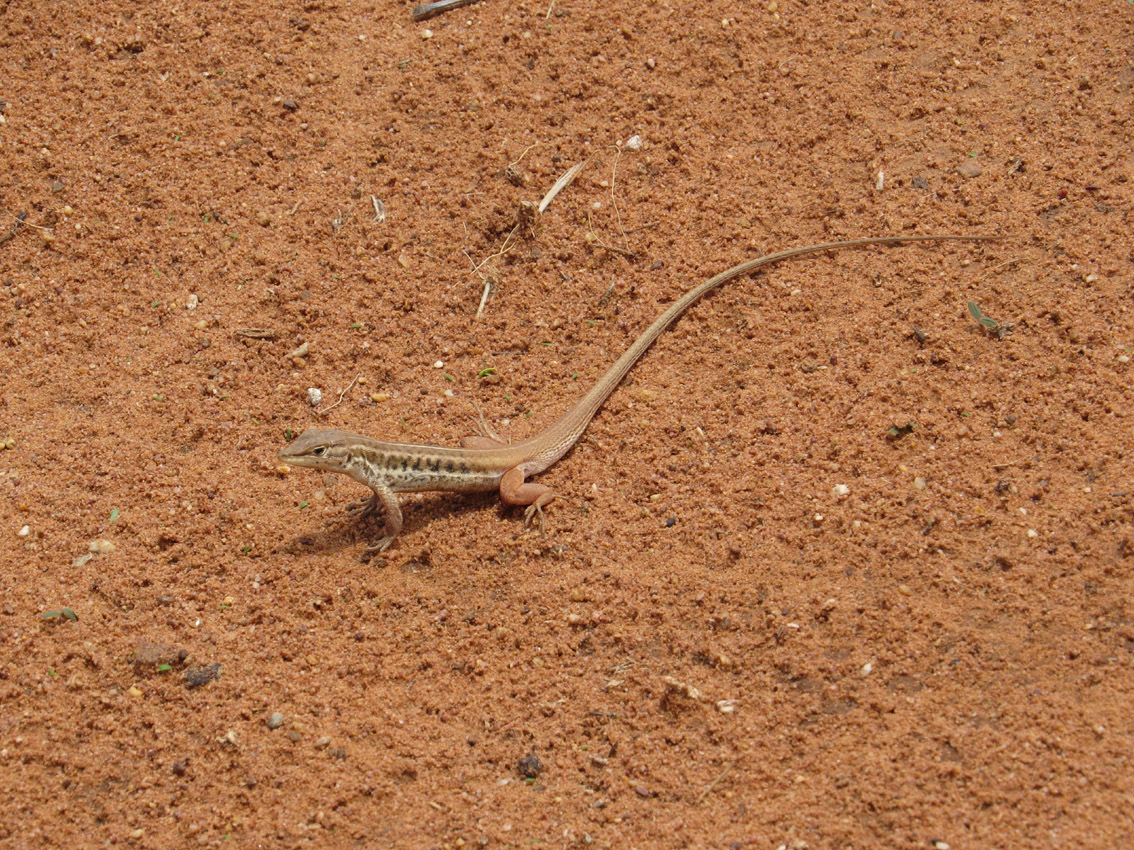
56. Leopard tortoise.
Large land leopard turtles run in all directions, periodically frightening observers. Since they are heard from afar on rocky ground, you unwittingly expect to meet a large animal.
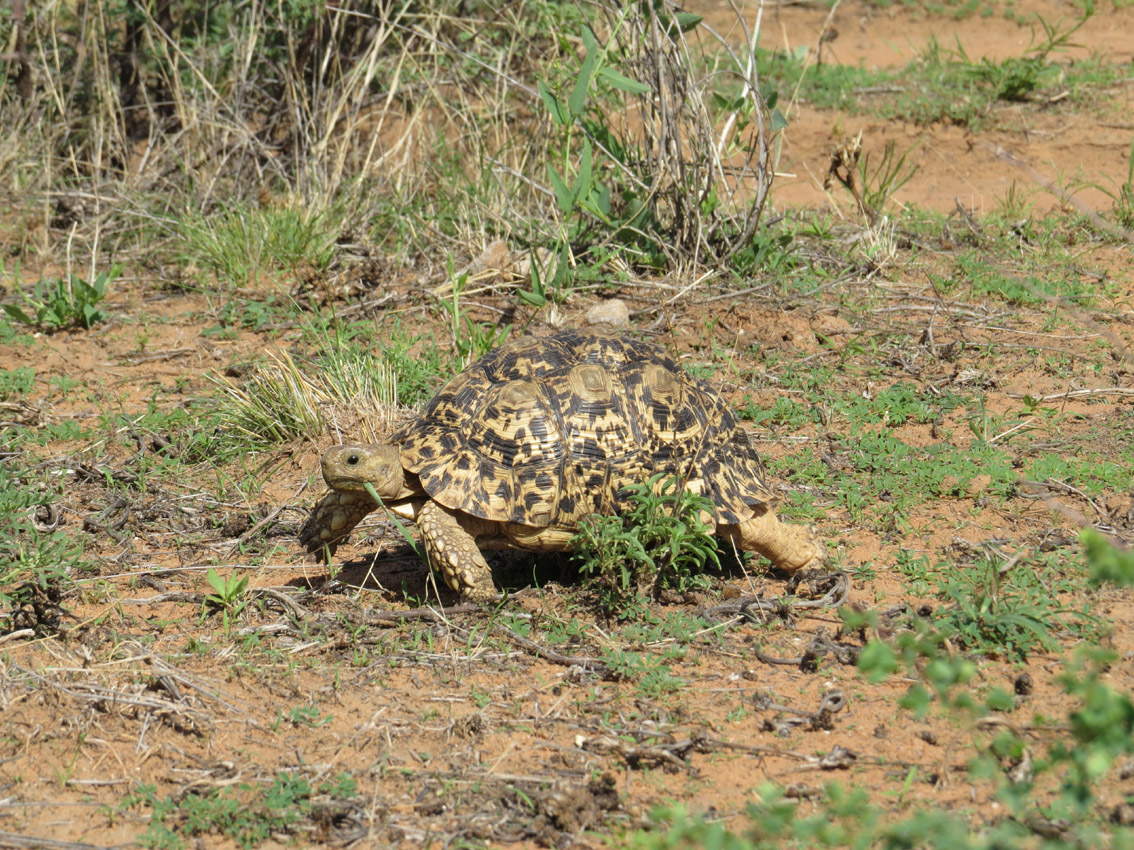
57. Meat flower.
This strange flower lies on the ground and smells of rotten meat to attract flies for pollination.
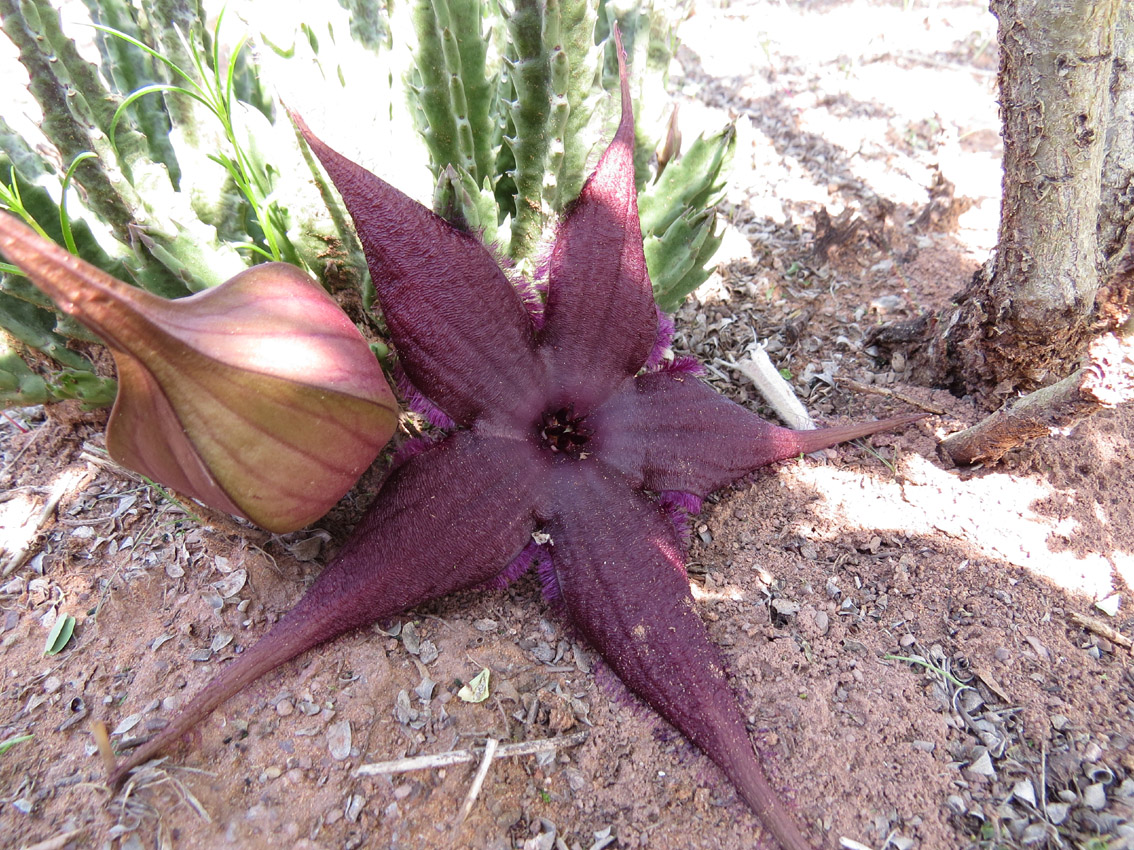
58. Bat-eared fox.
This tame fox lives in the tourist center of the Okambara Elephant Ranch.
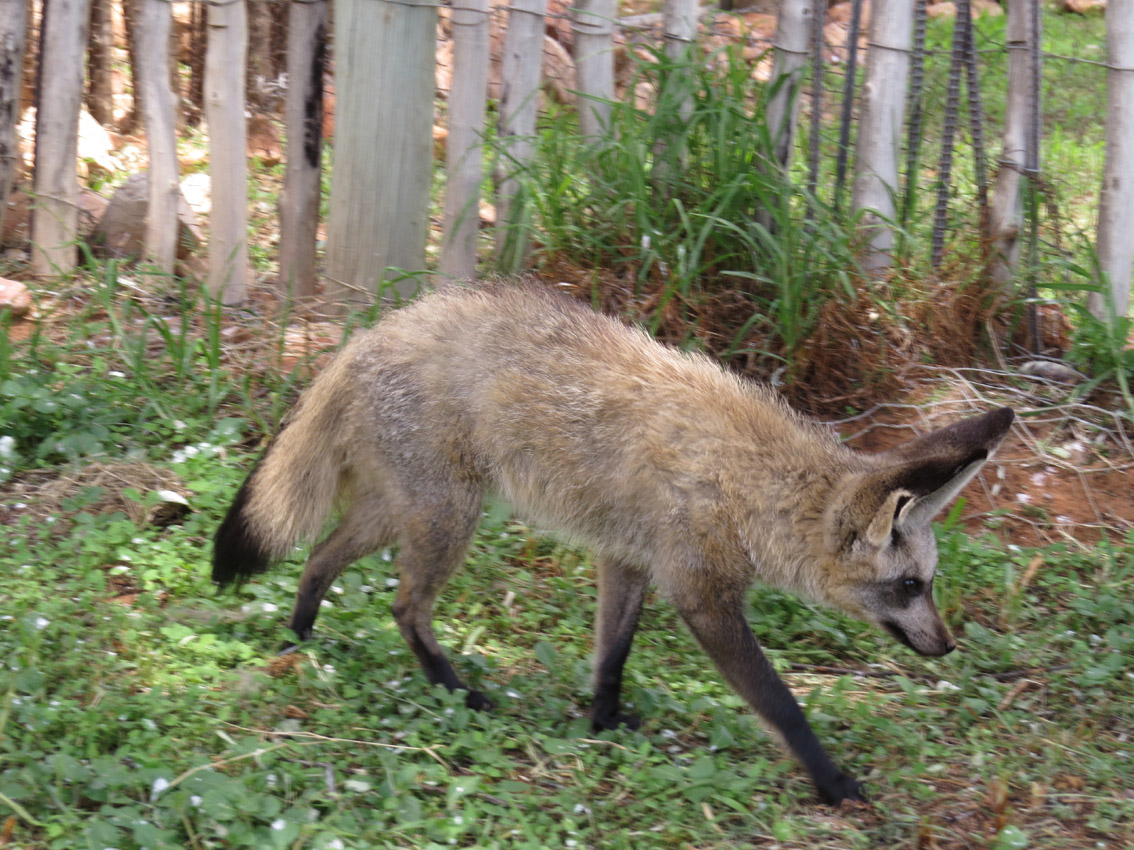
59. Traps for cheetahs and leopards.
Our German colleagues studying cheetahs and leopards in Namibia constructed a trap that selectively catches only these species. The animals are then put on radio collars to track their home ranges and released. Cheetahs are very fast, and can jump out while the door closes. Therefore, at this trap, the doors are locked by magnets, and it only works when the animal is exactly in the middle. In some traps, playbacks of cheetah calls recorded by us were used as bait.
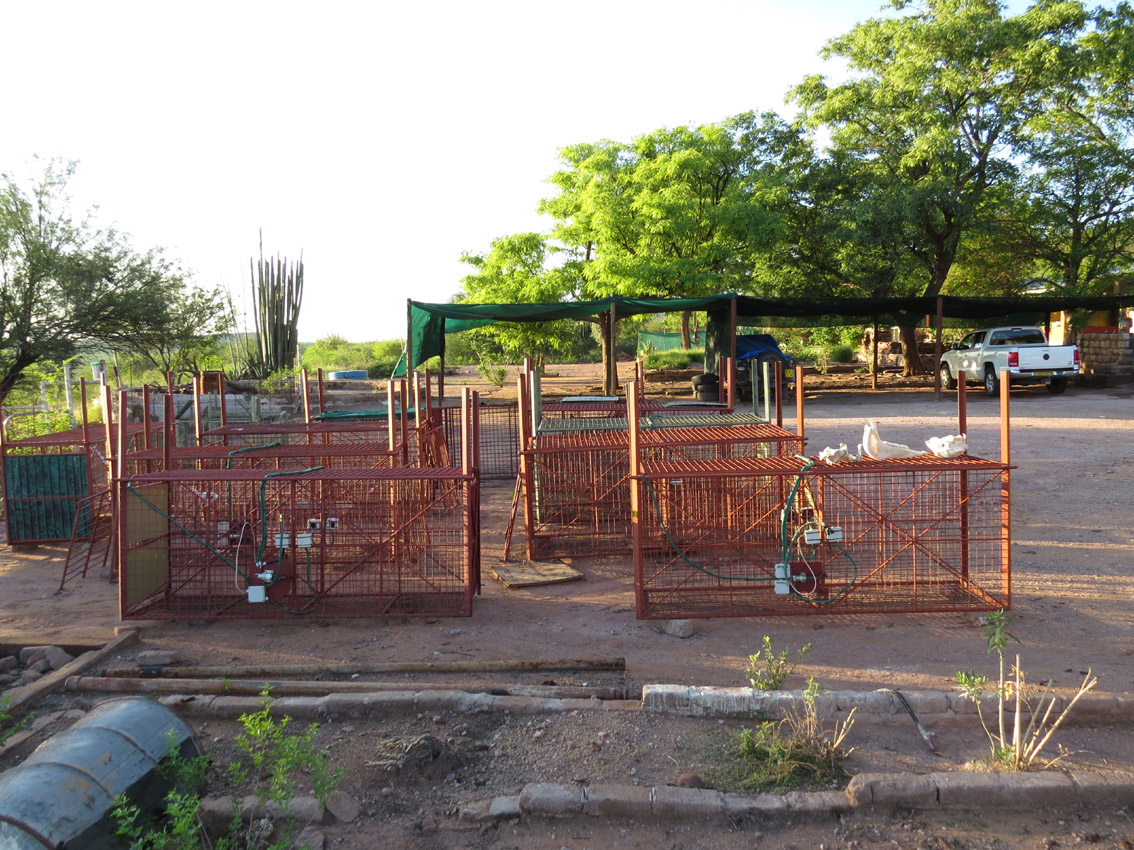
60. Green bush.
A month ago, before the rains, the prickly acacia bushes looked dry. And now the bush, the main habitat of impala, is amazing with fresh greenery. We depart with several hundred hours of audio recordings, thousands of photos and video clips. See you again, Africa!
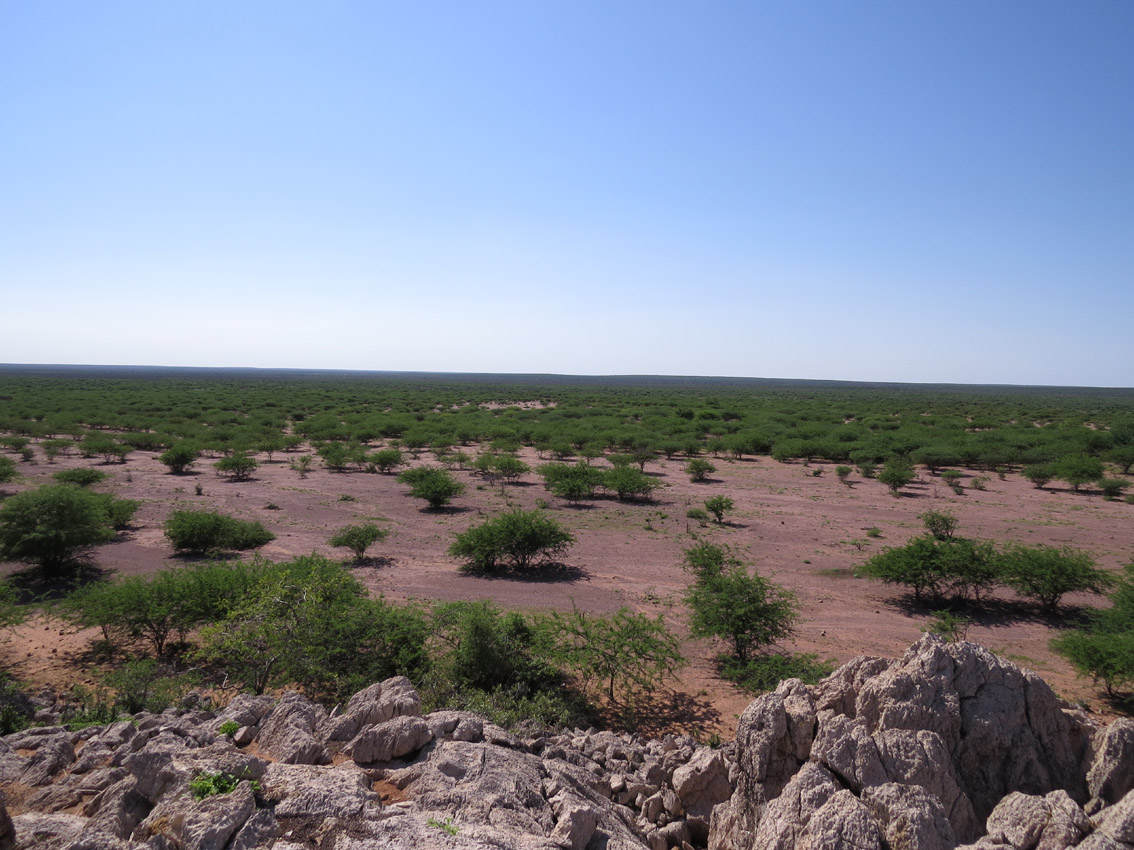
|



